United States military beret flash






In the United States (US) Department of Defense, a beret flash is a shield-shaped embroidered cloth that is 2.25 in (5.72 cm) tall and 1.875 in (4.76 cm) wide with a semi–circular base that is attached to a stiffener backing of a military beret.[1][2][3][4] These flashes—a British word for colorful embroidered patches worn on military berets—are worn over the left eye with the excess cloth of the beret shaped, folded, and pulled over the right ear giving it a distinctive appearance.[1][2][3] The embroidered designs of the Army's beret flashes represent the heraldic colors and patterns of a unit with a unique mission or represent the Army overall.[5] The Air Force's beret flashes represent their Air Force Specialty Code (AFSC) or their assignment to a unit with a unique mission.[2] Joint beret flashes—such as those worn by the Joint Communications Support Element (JCSE) and the Multinational Force and Observers—are worn by all who are assigned to the joint unit, given their uniform regulations allow.[6][7]
With the exception of some joint beret flashes, Army soldiers and Non–Commissioned Officers (NCOs) affix their Distinctive Unit Insignia (DUI) to the center of their beret flash unless assigned to a unit not authorized a DUI, then their regimental distinctive insignia is worn.[1] Army warrant officers and commissioned officers affix their polished metal rank insignia to the center of their beret flash while chaplains affix their polished metal branch insignia.[1] Air Force commissioned officers in the security forces or assigned to a combat aviation advisor squadron wear their beret flash in the same manner as the Army while Tactical Air Control Party (TACP) officers attach a miniature version of their polished metal rank insignia below the TACP Crest on the TACP Beret Flash.[2][8] Air Force airman and NCOs only wear their beret flash or beret flash with crest.[2][8]
The design of all Department of Defense beret flashes are created and/or approved by The Institute of Heraldry, Department of the Army.[9] For formations authorized a beret flash but have not yet been awarded one, the institute will conduct research into the requesting unit's heraldry, as well as design suggestions from the unit, in the creation of a new unit–specific beret flash.[10][11] Leveraging geometrical divisions, shapes, and colors, a heraldic artist will create a design that will represent the history and mission of the requesting unit.[10][11] Once the unit agrees upon a design, the institute will create manufacturing instructions and monitor their creation by companies authorized to produce the beret flash.[11][12][13]
US Department of Defense beret flash history[]
US Army[]

Throughout its history, Army units have adopted different headgear and headgear devices—such as various color accoutrements and insignias—to identify specific units, the unique mission of a unit, and/or the unique roles of soldiers.[4][14][15] According to some historians, the first US military use of a beret flash was created and worn by the 509th Parachute Infantry Regiment.[3][16][17] The 509th trained with the British 1st Airborne Division during World War II and was made honorary members of the British airborne forces in 1943, entitling them to wear the maroon beret worn by British paratroopers.[17][18] Some 509th paratroopers had a small hand–embroidered version of their regiment's gold and black pocket–patch created for use as their beret flash on their honorary maroon berets.[3][16][17][19] The design of the 509th's pocket–patch depicts a stylized figure of a paratrooper standing at the exit–door of an aircraft wearing a reserve parachute with an artistic rendering of the number "509" surrounding the paratrooper's head and the word "GERONIMO" displayed at the base of the door.[3][16][17][19]
 11th Special Forces Group Beret Flash—note design similarities with the unit's recognition bar 11th Special Forces Group Recognition Bar |
 A medical corps paratrooper with the 11th Special Forces Group wearing rifle-green beret with 1st Special Forces DUI above his unit's recognition bar, c. 1967[20] |
The official start of the Army's beret flashes began in 1961 with Department of the Army Message 578636 authorizing the establishment of organizational beret flashes for wear on the special forces' rifle–green beret.[3][21] In this message, the beret flash is described as shield–shaped with a semi–circular base made of felt 2 in (51 mm) tall and 1.625 in (41 mm) wide using solid colors to represent each of the special forces groups of the era.[3][21] The message also described who was authorized to wear the organizational beret flash stating that only special operations qualified paratroopers would be permitted to wear their special forces unit's organizational beret flash.[21] Each of these special forces group beret flashes were to be worn centered over the left eye with either the 1st Special Forces—later designated 1st Special Forces Command—DUI, polished metal officer rank insignia, or chaplain branch insignia centered on the flash.[4][21] Non–qualified paratroopers assigned to a special forces unit were to wear their Parachutist Badge with officers affixing their polished metal rank insignia or chaplain branch insignia below it on the rifle–green beret.[21] Later, non–qualified soldiers assigned to a special forces unit wore a cloth recognition bar, 1.875 in (4.76 cm) long and 0.5 in (1.27 cm) wide color and pattern matched to their group's organizational beret flash below the 1st Special Force DUI, polished metal officer rank insignia, or chaplain branch insignia on the rifle–green beret.[4][22][23]


Various beret accouterments began to appear in the 1960s and 70s, particularly between 1973 and 1979 when the Department of the Army had its morale–enhancing order in effect and different colored berets began to be worn by numerous units and branches of the Army.[25][26][27][28] Historical photographs from the 1960s through the 1970s show soldiers assigned to long-range reconnaissance patrol units wearing black berets with a wide variety of custom–made beret flashes that were worn over the left eye (see Example 1).[28] In 1973, Army leaders authorized the wear of the maroon beret by airborne units.[25][28] Within a year or so, paratroopers of the 82nd Airborne Division began incorporating organizational beret flashes onto their maroon berets pattered after their unit's background trimming behind their DUI, polished metal officer rank insignia, or chaplain branch insignia and worn centered over the left eye.[1][24][29] Similarly, in 1974 Army leaders authorized the 101st Airborne Division at Fort Campbell to wear the dark–blue beret when it was reorganized into an air assault unit.[14][26][28][30][31][32] Army articles and historical photographs of 101st soldiers show them wearing traditional organizational beret flashes patterned after their unit's background trimming—just like the 82nd Airborne's—with enlisted and NCOs affixing their DUI while officers affixed their polished metal rank insignia or chaplin branch insignia.[14][28][30][32] Between 1976 and 1977, 101st soldiers would add their Airmobile Badge—renamed Air Assault Badge in 1978—to their berets and wore them to the left of their beret flash (see Example 2).[14][28][32][33] Some other Fort Campbell units of the era also wore the dark–blue beret as well as red for headquarters command and kelly–green for military police, all with traditional organizational beret flashes placed centered over the left eye.[26][28] In 1975, the Army authorized its ranger units to wear the black beret.[34] If earned, some of these ranger units had their rangers affix their ranger tab to the top edge of their organizational beret flash along with the 75th Ranger Regiment DUI or polished metal officer rank insignia affixed to its center and was worn over the left eye or temple (see Example 3).[28][34] Also during the 1970s, arctic–qualified soldiers of the 172nd Infantry Brigade began to wear locally authorized olive–drab berets with traditionally styled organizational beret flashes that were unique to each battalion, and were worn in the same manner as beret flashes are today (see Example 4).[1][27][28][35] Additionally, versions cavalry and armor units began wearing black berets with some adopting organizational beret flashes of various shapes and colors and many wore them differently than other Army units of the era.[26][27][28] For example, armored cavalry regiments stationed in West Germany began wearing black berets in the 1970s with a maroon and white oval as their beret flash.[26][27][28] The oval beret flash was worn vertically on the black beret behind their DUI to the left of their metal rank insignia or chaplin branch insignia and positioned over the left temple (see Example 5).[26][27][28][36] Another example is the 1st Cavalry Division's use of various colored berets that represented the different capabilities of the division when it was converted to an experimental triple capability formation in 1971: black for armor, light–blue for infantry, red for artillery, and kelly–green for support.[28][37][38] When the experiment ended in 1974, the 1st Cavalry was converted to an armor formation and the division carried over its use of the black beret for its soldiers.[28][38] As they became available, 1st Cavalry soldiers affixed a battalion or squadron specific organizational beret flash to their berets, some were similar in design to today's beret flashes while others were unique in their shape.[3][28] Historical photographs show many 1st Cavalry soldiers wearing their beret in the same manner as soldiers in the armored cavalry regiments stationed in West Germany (see Example 6).[28][36] By 1979, the Army put a stop to the use of berets by conventional forces, leaving only special forces and ranger units the authority to wear berets.[26][27][28]











In 1980, the Army reversed part of its decision allowing airborne units to wear maroon berets, ranger units black berets—which switched to tan berets in 2001[27]—and special forces units rifle–green berets.[26][27][41] The Army's 1981 uniform regulation describes the wear of these newly approved berets with the only authorized accoutrements being officer rank insignias, chaplain branch insignias, DUIs, organizational beret flashes, and recognition bars.[4][42] The organizational beret flash did not become the norm until 1984 when the recognition bar was discontinued after the special forces tab became authorized for wear by special forces qualified paratroopers.[22] At which time, all soldiers assigned to a special forces unit, regardless of qualification, wore their unit's organizational beret flash on either the rifle–green beret—for special forces qualified paratroopers—or maroon beret—for support paratroopers.[1]
In 2000, General Eric Shinseki, Chief of Staff of the Army, decided to make the black beret the standard headgear of the Army.[1][9][27] General Shinseki also decided that a new Department of the Army Beret Flash be worn on the black beret.[9][27][43] This Army flash is designed to resemble the flag of the Commander–in–Chief of the Continental Army at the time of its victory at Yorktown in 1781 and is worn in the same manner as all beret flashes in the modern Army (see Example 1).[1][27][44] According to Department of the Army Pamphlet 670–1, the Department of the Army Beret Flash is to be worn by all units "unless authorization for another flash was granted before implementing the black beret as a standard Army headgear".[1] Army units can request an organizational beret flash for their formation from The Institute of Heraldry given it is not for wear on the black beret.[1][10][45] A good example of this is The Institute of Heraldry's 2018 authorization of organizational beret flashes for the Security Force Assistance Command and its brigades—known as an SFAB ["S Fab"]—for wear on their brown berets (see Example 2).[1][46][47][48][49][50][51][52] In the 21st century, Army organizational beret flashes are worn to signify a specific formation of a specialized unit, such as an active airborne, ranger, special forces, or combat advisor unit.[1][5][15][25] Additionally, there is a unique beret flash worn by special forces soldiers on their rifle–green beret when assigned to a unit not authorized an organizational beret flash (see Example 3).[1]
US Air Force[]
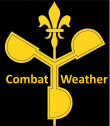


In the mid 1960s, Air Force commando weathermen,[58] formally known as weather parachutists, with Detachment 26 of the 30th Weather Squadron and Detachment 32 of the 5th Weather Squadron informally wore black berets.[57] The beret flash worn on these berets was a black cloth rectangle with a depiction of a yellow embroidered anemometer surmounted by a fleur–de–lis with the words “Combat Weather” split by the anemometer.[57] From 1970 through the 1980s, weather parachutists with the 5th Weather Squadron wore maroon berets with an Army style beret flash that incorporated the squadron's design and colors from their emblem's alchemical symbol for water and wore their Parachutist Badge affixed to the flash.[10][57] In 1979, weather parachutists, now called Special Operations Weather Teams (SOWTs), were authorized to wear navy–blue berets with an Army style beret flash consisting of a blue and black field surrounded by yellow piping.[10][57] Enlisted and NCOs wore their Parachutist Badge affixed to the flash while officers wore their polished metal rank insignia.[57] In 1986, the gray beret was authorized for wear by all SOWTs who continued to wear the aforementioned cloth beret flash until a new large color metallic SOWT Crest was authorized.[57] In 1992, the Air Force approved the return of the SOWT's blue, black, and yellow beret flash from the 70s and affixed their large color metallic SOWT Crest to it.[57] In 1996, the SOWTs assigned to Air Force Special Operations Command (AFSOC) wore a new Army style beret flash while those assigned to Air Combat Command, known as Combat Weather Teams (CWTs), continued to wear the blue, black and yellow beret flash.[10][57][59] The AFSOC SOWT Beret Flash consisted of a red border representing the blood shed by their predecessors, a black background representing special operations, and three diagonal lines of various colors representing the services they supported (green=Army, purple=joint forces, and blue=Air Force).[57] Enlisted and NCOs wore their Parachutist Badge on top of the AFSOC SOWT Beret Flash while officers wore their polished metal rank insignia until 2002 when the Combat Weather Team Crest was created.[57] The Combat Weather Team Crest was worn affixed on both SOWT and CWT beret flashes by enlisted and NCOs while officers continued to affix their polished metal rank insignia.[57][60][61] In 2007/2008, the AFSOC SOWT Beret Flash stopped being worn and in 2009—when the Special Operations Weather AFSC was established—a new large polished metallic Special Operations Weather Crest was approved for wear by all SOWTs and CWTs (enlisted, NCOs, and officers alike) on their gray berets.[2][57][60][62][63]
 CWT Beret Flash |
 A weather parachutist NCO with the 82nd Airborne Division wearing gray beret with CWT Beret Flash and Combat Weather Team Crest, 2007[64] |
 SOWT Beret Flash |
 A weather parachutist with the 107th Weather Flight wearing gray beret with SOWT Beret Flash and Combat Weather Team Crest, 2008[60] |
In 1966/67, the newly formed 1041st Security Police Squadron was authorized to wear a dark–blue beret with a unique organizational beret flash.[65][66][67] The 1041st's beret flash had a depiction of a falcon carrying a pair of lightning bolts on a somewhat pointed oval-shaped light-blue patch that was worn over the left temple.[65][66][67] In 1976, the Air Force approved the navy-blue beret, worn by Strategic Air Command's Elite Guard and Air Force Combat Control Teams, as the official uniform item for all Air Force police and security forces.[65][68] In 1997, the Air Force stood up the security forces AFSC and honored the heraldry of the 1041st Security Police Squadron by creating a new organizational beret flash for all security forces airman and NCOs that depict the 1041st's falcon over an airfield with the motto "Defensor Fortis" (defenders of the force) embroidered on a scroll at its base.[2][65] Security forces officers wear the same basic beret flash minus the embroidered falcon and airfield and in its place affix their polished metal rank insignia.[2]
 1041st Security Police Squadron Beret Flash |
 A security policeman with the 1041st Security Police Squadron wearing their distinctive dark–blue beret and beret flash, c. 1968[66] |
 Security Forces Beret Flash |
 A security forces airman with the 55th Security Forces Squadron wearing navy–blue beret with Security Forces Beret Flash, 1998[69] |
In 1979, TACP airman and NCOs were given authorization to wear the black beret. In 1984, two TACP's submitted a design for a unique beret flash and crest for wear on their berets which the Air Force approved one year later.[26] The TACP Beret Flash—which followed the basic design language of Army beret flashes[10]—incorporates red borders that represent the firepower TACP's bring to bear with two dovetailed fields of blue and green represent the close working relationship between the Air Force and the Army that is enabled by the TACP.[70] Later, air liaison officers were given authorization to wear the black beret and the TACP Beret Flash.[26][71][72] In 2019 the Air Force uniform instruction changed directing air liaison officers, now called TACP Officers, to wear the TACP Beret Flash and Crest with miniature polished metal rank insignia below the crest and just above the inner–border of the beret flash.[2][73][74] Similarly, Air Mobility Liaison Officers (AMLOs) also wore the black beret.[26] Although worn informally before then, in 2015 The Institute of Heraldry authorized a slight modification of the TACP Beret Flash for wear by AMLOs, incorporating an embroidered compass rose in the upper–left corner of the beret flash, and was worn in the same manner as Army beret flashes.[1][2][75][76] Despite this, the Air Force Uniform Board and uniform regulations do not address the wear of the AMLO Beret Flash by these liaison officers.[2]
 TACP Beret Flash |
 An air liaison officer with the 682nd Air Support Operations Squadron wearing black beret with TACP Beret Flash and rank insignia (captain), 2011[77] |
 The Institute of Heraldry manufacturing instructions for the AMLO Beret Flash, 2015[76] |
 An AMLO with the 8th Air Support Operations Squadron wearing black beret with AMLO Beret Flash and rank insignia (captain)—note the compass rose at the upper-left corner—2011[75] |


In 2018, AFSOC authorized the wear of the brown beret for airman, NCOs, and officers assigned to a combat aviation advisor squadron, specifically the 6th and 711th Special Operations Squadrons. The brown beret—similar to the Army's brown beret—is worn with an Army style organizational beret flash consisting of a dark–blue field with olive–green diagonal stripes and border.[10][79] The Combat Aviation Advisor Beret Flash is worn centered over the left eye with polished metal officer rank insignia, chaplain branch insignia, or an AFSC metallic beret crest—such as the Survival, Evasion, Resistance and Escape (SERE) Specialist Crest—affixed to the beret flash while all other advisors wear the cloth Combat Aviation Advisor Beret Flash without accoutrements.[78][79]
[]
In the 1960s, select Navy riverine patrol units operating in South Vietnam adopted the black beret to be part of their daily uniform and wore various accouterments on their berets.[80][81] In 1967, the Commander of the Riverine Patrol Force sent an official message to the Commander of River Patrol Flotilla Five authorizing the wear of the black beret.[81] In this message, the wear and appearance of the beret was defined stating, "Beret will be worn with river patrol force insignia centered on right side" and "Only standard size river patrol force insignia will be worn on beret. ... No other emblem or rank insignia will be displayed on beret"[81][82] Today, these Navy small boat units honor their heritage by wearing the black beret during special occasions—such as induction ceremonies into the Gamewardens Association[83]—and will affix historically relevant riverine task force insignia for use as their beret flash.[84][85][86][87]
 River Patrol Force, Task Force 116 Insignia |
 Chief of Naval Operations (L) and Commander, Riverine Patrol Force (R) wearing black berets with Task Force 116 Insignia, 1969[88]  A Navy NCO from Riverine Squadron 1 receives the historical black beret with Task Force 116 Insignia at a ceremony making him an honorary "Gamewarden," 2011[85] |
Beret flashes of the US military[]
Notes to readers:
|
Joint[]
 Joint Enabling Capabilities Command (JECC), JCSE
Joint Enabling Capabilities Command (JECC), JCSE JECC, JCSE, 1st Squadron
JECC, JCSE, 1st Squadron JECC, JCSE, 2nd Squadron
JECC, JCSE, 2nd Squadron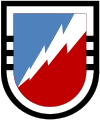 JECC, JCSE, 3rd Squadron
JECC, JCSE, 3rd Squadron JECC, JCSE, 4th Squadron
JECC, JCSE, 4th Squadron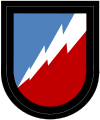 JECC, JCSE, Communications Support Detachment
JECC, JCSE, Communications Support Detachment Multinational Force and Observers
Multinational Force and Observers
Air Force[]
 Combat Aviation Advisor
Combat Aviation Advisor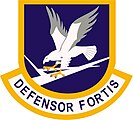 Security Forces
Security Forces Security Forces Officer
Security Forces Officer TACP and TACP Officer
TACP and TACP Officer
- Obsolete
 Air Liaison Officer
Air Liaison Officer AMLO
AMLO 1st Weather Group, 5th Weather Squadron
1st Weather Group, 5th Weather Squadron 1979–1986/1992–1996 SOWT and 1996–2010 CWT
1979–1986/1992–1996 SOWT and 1996–2010 CWT 1996–2008 AFSOC, SOWT
1996–2008 AFSOC, SOWT
Army[]
 Department of the Army
Department of the Army
Adjutant general[]
- Obsolete
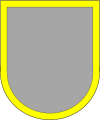 US Army Alaska, Fort Wainwright, Finance Element
US Army Alaska, Fort Wainwright, Finance Element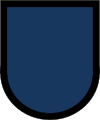 1st Cavalry Division, 15th Adjutant General Company
1st Cavalry Division, 15th Adjutant General Company XVIII Airborne Corps, 18th Personnel Group
XVIII Airborne Corps, 18th Personnel Group 82nd Airborne Division, 82nd Finance Battalion
82nd Airborne Division, 82nd Finance Battalion 82nd Airborne Division, 82nd Personnel Services Battalion
82nd Airborne Division, 82nd Personnel Services Battalion
Air defense artillery[]
 XVIII Airborne Corps, 108th Air Defense Artillery Brigade, 4th Air Defense Artillery Regiment, 3rd Battalion, Battery E
XVIII Airborne Corps, 108th Air Defense Artillery Brigade, 4th Air Defense Artillery Regiment, 3rd Battalion, Battery E
- Obsolete
 US Army Alaska, 172nd Infantry Brigade, 43rd Air Defense Artillery Regiment, 1st Battalion
US Army Alaska, 172nd Infantry Brigade, 43rd Air Defense Artillery Regiment, 1st Battalion 101st Airborne Division, 3rd Air Defense Artillery Regiment, 1st Battalion
101st Airborne Division, 3rd Air Defense Artillery Regiment, 1st Battalion
Armor and cavalry[]
 US Army Europe and Africa (USAREUR–AF), 173rd Airborne Brigade, 91st Cavalry Regiment, 1st Squadron
US Army Europe and Africa (USAREUR–AF), 173rd Airborne Brigade, 91st Cavalry Regiment, 1st Squadron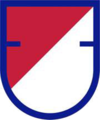 25th Infantry Division, 4th Brigade Combat Team, 40th Cavalry Regiment, 1st Squadron
25th Infantry Division, 4th Brigade Combat Team, 40th Cavalry Regiment, 1st Squadron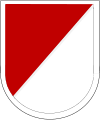 82nd Airborne Division, Combat Aviation Brigade, 17th Cavalry Regiment, 1st Squadron
82nd Airborne Division, Combat Aviation Brigade, 17th Cavalry Regiment, 1st Squadron 82nd Airborne Division, 1st Brigade Combat Team, 73rd Cavalry Regiment, 3rd Squadron
82nd Airborne Division, 1st Brigade Combat Team, 73rd Cavalry Regiment, 3rd Squadron 82nd Airborne Division, 2nd Brigade Combat Team, 73rd Cavalry Regiment, 1st Squadron
82nd Airborne Division, 2nd Brigade Combat Team, 73rd Cavalry Regiment, 1st Squadron 82nd Airborne Division, 3rd Brigade Combat Team, 73rd Cavalry Regiment, 5th Squadron
82nd Airborne Division, 3rd Brigade Combat Team, 73rd Cavalry Regiment, 5th Squadron
- Obsolete
 –US Army Europe, 2nd Armored Cavalry Regiment (West Germany) (original version)
–US Army Europe, 2nd Armored Cavalry Regiment (West Germany) (original version)
–US Army Europe, 11th Armored Cavalry Regiment, Reconnaissance Platoon (West Germany) –US Army Europe, 2nd Armored Cavalry Regiment (West Germany)
–US Army Europe, 2nd Armored Cavalry Regiment (West Germany)
–US Army Europe, 11th Armored Cavalry Regiment (West Germany)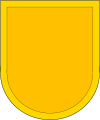 –1st Cavalry Division
–1st Cavalry Division
–US Army Alaska, 172nd Infantry Brigade, 1st Cavalry Regiment, Troop E 1st Cavalry Division, 9th Cavalry Regiment, 1st Squadron
1st Cavalry Division, 9th Cavalry Regiment, 1st Squadron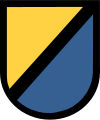 1st Cavalry Division, 10th Cavalry Regiment, 3rd Battalion
1st Cavalry Division, 10th Cavalry Regiment, 3rd Battalion 1st Cavalry Division, 1st Brigade, 8th Cavalry, 1st Battalion
1st Cavalry Division, 1st Brigade, 8th Cavalry, 1st Battalion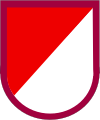 1st Cavalry Division, 1st Brigade, 8th Cavalry, 2nd Battalion
1st Cavalry Division, 1st Brigade, 8th Cavalry, 2nd Battalion 1st Cavalry Division, 1st Brigade, 12th Cavalry Regiment, 1st Battalion
1st Cavalry Division, 1st Brigade, 12th Cavalry Regiment, 1st Battalion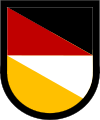 1st Cavalry Division, 2nd Brigade, 5th Cavalry, 1st Battalion
1st Cavalry Division, 2nd Brigade, 5th Cavalry, 1st Battalion 1st Cavalry Division, 2nd Brigade, 5th Cavalry, 2nd Battalion
1st Cavalry Division, 2nd Brigade, 5th Cavalry, 2nd Battalion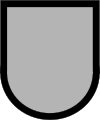 1st Cavalry Division, 3rd Brigade
1st Cavalry Division, 3rd Brigade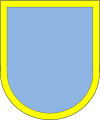 1st Cavalry Division, 3rd Brigade, 7th Cavalry, 2nd Battalion
1st Cavalry Division, 3rd Brigade, 7th Cavalry, 2nd Battalion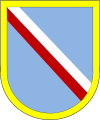 1st Cavalry Division, 3rd Brigade 7th Cavalry, 5th Battalion
1st Cavalry Division, 3rd Brigade 7th Cavalry, 5th Battalion –82nd Airborne Division, 1st Brigade Combat Team, 68th Armor Regiment, 4th Battalion, Company A
–82nd Airborne Division, 1st Brigade Combat Team, 68th Armor Regiment, 4th Battalion, Company A
–82nd Airborne Division, 73rd Armor Regiment, 3rd Battalion
–US Army Europe, 173rd Airborne Brigade, 16th Cavalry Regiment, Company D 82nd Airborne Division, 4th Brigade Combat Team, 73rd Cavalry Regiment, 4th Squadron
82nd Airborne Division, 4th Brigade Combat Team, 73rd Cavalry Regiment, 4th Squadron –82nd Airborne Division, 17th Cavalry Regiment, 1st Squadron (original version)
–82nd Airborne Division, 17th Cavalry Regiment, 1st Squadron (original version)
–III Corps, 3rd Armored Cavalry Regiment
–Tennessee Army National Guard, 278th Armored Cavalry Regiment
–Puerto Rico Army National Guard, 92nd Infantry Brigade, 192nd Cavalry Regiment, Troop E
–US Army Reserve Officers' Training Corps (ROTC), Temple University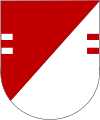 101st Airborne Division, 17th Cavalry Regiment, 2nd Squadron
101st Airborne Division, 17th Cavalry Regiment, 2nd Squadron
Aviation[]
 US Army Special Operations Aviation Command (USASOAC)
US Army Special Operations Aviation Command (USASOAC) USASOAC, 160th Special Operations Aviation Regiment
USASOAC, 160th Special Operations Aviation Regiment USASOAC, 160th Special Operations Aviation Regiment, 1st Battalion
USASOAC, 160th Special Operations Aviation Regiment, 1st Battalion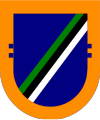 USASOAC, 160th Special Operations Aviation Regiment, 2nd Battalion
USASOAC, 160th Special Operations Aviation Regiment, 2nd Battalion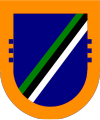 USASOAC, 160th Special Operations Aviation Regiment, 3rd Battalion
USASOAC, 160th Special Operations Aviation Regiment, 3rd Battalion USASOAC, 160th Special Operations Aviation Regiment, 4th Battalion
USASOAC, 160th Special Operations Aviation Regiment, 4th Battalion 82nd Airborne Division, Combat Aviation Brigade
82nd Airborne Division, Combat Aviation Brigade
—formerly:
–82nd Combat Aviation Battalion
–82nd Aviation Brigade 82nd Airborne Division, Combat Aviation Brigade, 82nd Aviation Regiment, 1st Battalion
82nd Airborne Division, Combat Aviation Brigade, 82nd Aviation Regiment, 1st Battalion 82nd Airborne Division, Combat Aviation Brigade, 82nd Aviation Regiment, 2nd Battalion
82nd Airborne Division, Combat Aviation Brigade, 82nd Aviation Regiment, 2nd Battalion 82nd Airborne Division, Combat Aviation Brigade, 82nd Aviation Regiment, 3rd Battalion
82nd Airborne Division, Combat Aviation Brigade, 82nd Aviation Regiment, 3rd Battalion
- Obsolete
 Special Operations Command South, 617th Special Operations Aviation Detachment
Special Operations Command South, 617th Special Operations Aviation Detachment US Army Alaska, 172nd Infantry Brigade, 222nd Aviation Battalion
US Army Alaska, 172nd Infantry Brigade, 222nd Aviation Battalion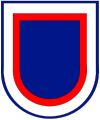 US Army Europe, 11th Aviation Brigade, Pathfinder Platoon
US Army Europe, 11th Aviation Brigade, Pathfinder Platoon US Army Special Operations Command (USASOC), 160th Special Operations Aviation Group
US Army Special Operations Command (USASOC), 160th Special Operations Aviation Group USASOC, 245th Special Operations Aviation Regiment, 1st Battalion
USASOC, 245th Special Operations Aviation Regiment, 1st Battalion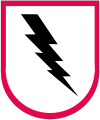 Washington National Guard, 81st Infantry Brigade, Aviation Section
Washington National Guard, 81st Infantry Brigade, Aviation Section V Corps, 12th Aviation Brigade, Pathfinder Platoon
V Corps, 12th Aviation Brigade, Pathfinder Platoon Eighth US Army, 17th Aviation Brigade, Pathfinder Platoon
Eighth US Army, 17th Aviation Brigade, Pathfinder Platoon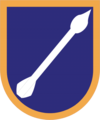 XVIII Airborne Corps, 18th Aviation Brigade
XVIII Airborne Corps, 18th Aviation Brigade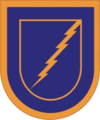 XVIII Airborne Corps, 58th Aviation Regiment, 1st Battalion
XVIII Airborne Corps, 58th Aviation Regiment, 1st Battalion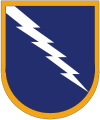 XVIII Airborne Corps, 229th Aviation Group
XVIII Airborne Corps, 229th Aviation Group 28th Infantry Division, 28th Infantry Detachment (Pathfinder) (original version)
28th Infantry Division, 28th Infantry Detachment (Pathfinder) (original version)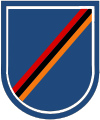 28th Infantry Division, 28th Infantry Detachment (Pathfinder)
28th Infantry Division, 28th Infantry Detachment (Pathfinder)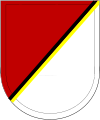 29th Infantry Division, 129th Infantry Detachment (Pathfinder)
29th Infantry Division, 129th Infantry Detachment (Pathfinder)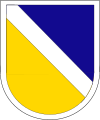 38th Infantry Division, 77th Infantry Detachment (Pathfinder)
38th Infantry Division, 77th Infantry Detachment (Pathfinder) 40th Infantry Division, 76th Infantry Detachment (Pathfinder)
40th Infantry Division, 76th Infantry Detachment (Pathfinder)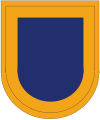 82nd Airborne Division, 82nd Aviation Brigade (original version)
82nd Airborne Division, 82nd Aviation Brigade (original version) 82nd Airborne Division, 82nd Aviation Regiment, 1st Battalion (original version)
82nd Airborne Division, 82nd Aviation Regiment, 1st Battalion (original version)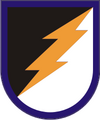 82nd Airborne Division, 82nd Aviation Regiment, 1st Battalion (second version)
82nd Airborne Division, 82nd Aviation Regiment, 1st Battalion (second version)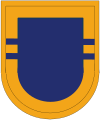 82nd Airborne Division, 82nd Aviation Regiment, 2nd Battalion (original version)
82nd Airborne Division, 82nd Aviation Regiment, 2nd Battalion (original version)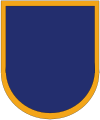 82nd Airborne Division, 82nd Combat Aviation Battalion
82nd Airborne Division, 82nd Combat Aviation Battalion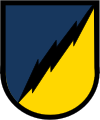 89th Army Reserve Command, 26th Infantry Platoon (Pathfinder)
89th Army Reserve Command, 26th Infantry Platoon (Pathfinder) 96th Army Reserve Command, 79th Infantry Platoon (Pathfinder)
96th Army Reserve Command, 79th Infantry Platoon (Pathfinder)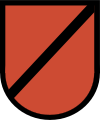 97th Army Reserve Command, 5th Infantry Platoon (Pathfinder)
97th Army Reserve Command, 5th Infantry Platoon (Pathfinder)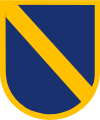 –101st Airborne Division, 101st Aviation Regiment
–101st Airborne Division, 101st Aviation Regiment
–1st Special Forces, 44th Chemical Detachment
Chemical[]
- Obsolete
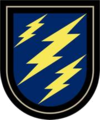 1st Special Forces, 5th Special Forces Group, 56th Chemical Reconnaissance Detachment
1st Special Forces, 5th Special Forces Group, 56th Chemical Reconnaissance Detachment –1st Special Forces, 44th Chemical Detachment
–1st Special Forces, 44th Chemical Detachment
–101st Airborne Division, 101st Aviation Regiment
Civil affairs[]
 US Army Civil Affairs and Psychological Operations Command (USACAPOC), 350th Civil Affairs Command, 1st Training Brigade, 478th Civil Affairs Battalion
US Army Civil Affairs and Psychological Operations Command (USACAPOC), 350th Civil Affairs Command, 1st Training Brigade, 478th Civil Affairs Battalion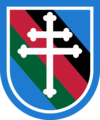 USACAPOC, 351st Civil Affairs Command, 358th Civil Affairs Brigade, 416th Civil Affairs Battalion
USACAPOC, 351st Civil Affairs Command, 358th Civil Affairs Brigade, 416th Civil Affairs Battalion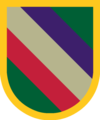 USACAPOC, 351st Civil Affairs Command, 358th Civil Affairs Brigade, 426th Civil Affairs Battalion
USACAPOC, 351st Civil Affairs Command, 358th Civil Affairs Brigade, 426th Civil Affairs Battalion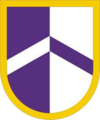 USACAPOC, 352nd Civil Affairs Command, 360th Civil Affairs Brigade
USACAPOC, 352nd Civil Affairs Command, 360th Civil Affairs Brigade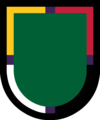 USACAPOC, 352nd Civil Affairs Command, 360th Civil Affairs Brigade, 404th Civil Affairs Battalion
USACAPOC, 352nd Civil Affairs Command, 360th Civil Affairs Brigade, 404th Civil Affairs Battalion USACAPOC, 352nd Civil Affairs Command, 360th Civil Affairs Brigade, 412th Civil Affairs Battalion
USACAPOC, 352nd Civil Affairs Command, 360th Civil Affairs Brigade, 412th Civil Affairs Battalion USACAPOC, 352nd Civil Affairs Command, 360th Civil Affairs Brigade, 450th Civil Affairs Battalion
USACAPOC, 352nd Civil Affairs Command, 360th Civil Affairs Brigade, 450th Civil Affairs Battalion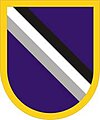 1st Special Forces Command, 95th Civil Affairs Brigade
1st Special Forces Command, 95th Civil Affairs Brigade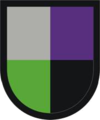 1st Special Forces Command, 95th Civil Affairs Brigade, 91st Civil Affairs Battalion
1st Special Forces Command, 95th Civil Affairs Brigade, 91st Civil Affairs Battalion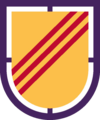 1st Special Forces Command, 95th Civil Affairs Brigade, 92nd Civil Affairs Battalion
1st Special Forces Command, 95th Civil Affairs Brigade, 92nd Civil Affairs Battalion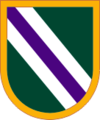 1st Special Forces Command, 95th Civil Affairs Brigade, 96th Civil Affairs Battalion
1st Special Forces Command, 95th Civil Affairs Brigade, 96th Civil Affairs Battalion 1st Special Forces Command, 95th Civil Affairs Brigade, 97th Civil Affairs Battalion
1st Special Forces Command, 95th Civil Affairs Brigade, 97th Civil Affairs Battalion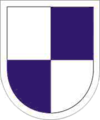 1st Special Forces Command, 95th Civil Affairs Brigade, 98th Civil Affairs Battalion
1st Special Forces Command, 95th Civil Affairs Brigade, 98th Civil Affairs Battalion
- Obsolete
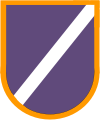 1st Special Forces Command, 95th Civil Affairs Brigade, 96th Civil Affairs Battalion, Company A
1st Special Forces Command, 95th Civil Affairs Brigade, 96th Civil Affairs Battalion, Company A
Engineers[]
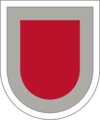 USAREUR–AF, 173rd Airborne Brigade, 54th Brigade Engineer Battalion
USAREUR–AF, 173rd Airborne Brigade, 54th Brigade Engineer Battalion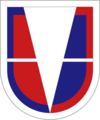 XVIII Airborne Corps, 20th Engineer Brigade, 27th Engineer Battalion
XVIII Airborne Corps, 20th Engineer Brigade, 27th Engineer Battalion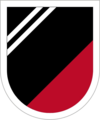 XVIII Airborne Corps, 20th Engineer Brigade, 27th Engineer Battalion, 57th Engineer Company
XVIII Airborne Corps, 20th Engineer Brigade, 27th Engineer Battalion, 57th Engineer Company XVIII Airborne Corps, 20th Engineer Brigade, 27th Engineer Battalion, 161st Engineer Company
XVIII Airborne Corps, 20th Engineer Brigade, 27th Engineer Battalion, 161st Engineer Company XVIII Airborne Corps, 20th Engineer Brigade, 27th Engineer Battalion, 618th Engineer Company
XVIII Airborne Corps, 20th Engineer Brigade, 27th Engineer Battalion, 618th Engineer Company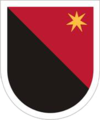 25th Infantry Division, 4th Brigade Combat Team, 6th Brigade Engineer Battalion
25th Infantry Division, 4th Brigade Combat Team, 6th Brigade Engineer Battalion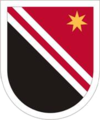 25th Infantry Division, 4th Brigade Combat Team, 6th Brigade Engineer Battalion, 84th Engineer Company
25th Infantry Division, 4th Brigade Combat Team, 6th Brigade Engineer Battalion, 84th Engineer Company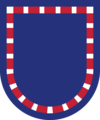 82nd Airborne Division, 1st Brigade Combat Team, 127th Brigade Engineer Battalion
82nd Airborne Division, 1st Brigade Combat Team, 127th Brigade Engineer Battalion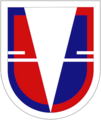 82nd Airborne Division, 2nd Brigade Combat Team, 37th Brigade Engineer Battalion
82nd Airborne Division, 2nd Brigade Combat Team, 37th Brigade Engineer Battalion 82nd Airborne Division, 3rd Brigade Combat Team, 307th Brigade Engineer Battalion
82nd Airborne Division, 3rd Brigade Combat Team, 307th Brigade Engineer Battalion
- Obsolete
 US Army Alaska, Fort Wainwright, 47th Engineer Company
US Army Alaska, Fort Wainwright, 47th Engineer Company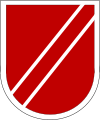 US Army Alaska, 172nd Infantry Brigade, 562nd Engineer Company
US Army Alaska, 172nd Infantry Brigade, 562nd Engineer Company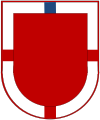 US Army Forces Command, 20th Engineer Battalion
US Army Forces Command, 20th Engineer Battalion –1st Cavalry Division, 8th Engineer Battalion
–1st Cavalry Division, 8th Engineer Battalion
–1st Cavalry Division, 1st Cavalry Division Artillery (original version) XVIII Airborne Corps, 20th Engineer Brigade (original version)
XVIII Airborne Corps, 20th Engineer Brigade (original version)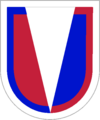 XVIII Airborne Corps, 20th Engineer Brigade
XVIII Airborne Corps, 20th Engineer Brigade XVIII Airborne Corps, 20th Engineer Brigade, 738th Engineer Company
XVIII Airborne Corps, 20th Engineer Brigade, 738th Engineer Company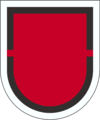 XVIII Airborne Corps, 20th Engineer Brigade, 919th Engineer Company
XVIII Airborne Corps, 20th Engineer Brigade, 919th Engineer Company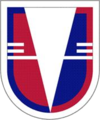 XVIII Airborne Corps, 20th Engineer Brigade, 30th Engineer Battalion
XVIII Airborne Corps, 20th Engineer Brigade, 30th Engineer Battalion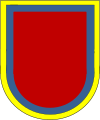 82nd Airborne Division, 127th Engineer Battalion (original version)
82nd Airborne Division, 127th Engineer Battalion (original version)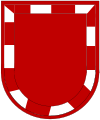 101st Airborne Division, 326th Engineer Battalion
101st Airborne Division, 326th Engineer Battalion
Field artillery[]
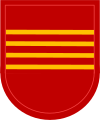 USAREUR–AF, 173rd Airborne Brigade, 319th Field Artillery Regiment, 4th Battalion
USAREUR–AF, 173rd Airborne Brigade, 319th Field Artillery Regiment, 4th Battalion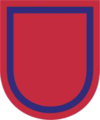 25th Infantry Division, 4th Brigade Combat Team, 377th Field Artillery Regiment, 2nd Battalion
25th Infantry Division, 4th Brigade Combat Team, 377th Field Artillery Regiment, 2nd Battalion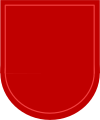 82nd Airborne Division, 82nd Airborne Division Artillery
82nd Airborne Division, 82nd Airborne Division Artillery
—formerly 101st Airborne Division, 101st Airborne Division Artillery 82nd Airborne Division, 1st Brigade Combat Team, 319th Field Artillery Regiment, 3rd Battalion
82nd Airborne Division, 1st Brigade Combat Team, 319th Field Artillery Regiment, 3rd Battalion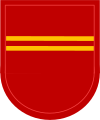 82nd Airborne Division, 2nd Brigade Combat Team, 319th Field Artillery Regiment, 2nd Battalion
82nd Airborne Division, 2nd Brigade Combat Team, 319th Field Artillery Regiment, 2nd Battalion 82nd Airborne Division, 3rd Brigade Combat Team, 319th Field Artillery Regiment, 1st Battalion
82nd Airborne Division, 3rd Brigade Combat Team, 319th Field Artillery Regiment, 1st Battalion
- Obsolete
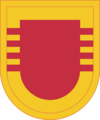 US Army Alaska, 172nd Infantry Brigade, 11th Field Artillery Regiment, 4th Battalion, Battery C
US Army Alaska, 172nd Infantry Brigade, 11th Field Artillery Regiment, 4th Battalion, Battery C –1st Cavalry Division, 1st Cavalry Division Artillery (original version)
–1st Cavalry Division, 1st Cavalry Division Artillery (original version)
–1st Cavalry Division, 8th Engineer Battalion –1st Cavalry Division, 1st Cavalry Division Artillery
–1st Cavalry Division, 1st Cavalry Division Artillery
–US Army Alaska, 172nd Infantry Brigade, 37th Field Artillery Regiment, 1st Battalion, Battery C XVIII Airborne Corps, XVIII Airborne Corps Artillery
XVIII Airborne Corps, XVIII Airborne Corps Artillery XVIII Airborne Corps, 18th Field Artillery Brigade
XVIII Airborne Corps, 18th Field Artillery Brigade XVIII Airborne Corps, 18th Field Artillery Brigade, 1st Field Artillery Detachment
XVIII Airborne Corps, 18th Field Artillery Brigade, 1st Field Artillery Detachment XVIII Airborne Corps, 18th Field Artillery Brigade, 234th Field Artillery Detachment
XVIII Airborne Corps, 18th Field Artillery Brigade, 234th Field Artillery Detachment XVIII Airborne Corps, 18th Field Artillery Brigade, 321st Field Artillery Regiment, 1st Battalion
XVIII Airborne Corps, 18th Field Artillery Brigade, 321st Field Artillery Regiment, 1st Battalion XVIII Airborne Corps, 18th Field Artillery Brigade, 377th Field Artillery Regiment, 1st Battalion
XVIII Airborne Corps, 18th Field Artillery Brigade, 377th Field Artillery Regiment, 1st Battalion 82nd Airborne Division, 4th Brigade Combat Team, 321st Field Artillery Regiment, 2nd Battalion
82nd Airborne Division, 4th Brigade Combat Team, 321st Field Artillery Regiment, 2nd Battalion
Infantry[]
 USAREUR–AF, 173rd Airborne Brigade
USAREUR–AF, 173rd Airborne Brigade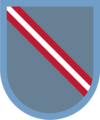 USAREUR–AF, 173rd Airborne Brigade, 143rd Infantry Regiment, 1st Battalion
USAREUR–AF, 173rd Airborne Brigade, 143rd Infantry Regiment, 1st Battalion USAREUR–AF, 173rd Airborne Brigade, 503rd Infantry Regiment, 1st Battalion
USAREUR–AF, 173rd Airborne Brigade, 503rd Infantry Regiment, 1st Battalion
—formerly 101st Airborne Division, 3rd Brigade USAREUR–AF, 173rd Airborne Brigade, 503rd Infantry Regiment, 2nd Battalion
USAREUR–AF, 173rd Airborne Brigade, 503rd Infantry Regiment, 2nd Battalion
—formerly 101st Airborne Division, 3rd Brigade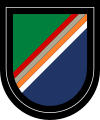 USASOC, 75th Ranger Regiment
USASOC, 75th Ranger Regiment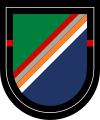 USASOC, 75th Ranger Regiment, 1st Battalion
USASOC, 75th Ranger Regiment, 1st Battalion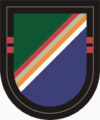 USASOC, 75th Ranger Regiment, 2nd Battalion
USASOC, 75th Ranger Regiment, 2nd Battalion USASOC, 75th Ranger Regiment, 3rd Battalion
USASOC, 75th Ranger Regiment, 3rd Battalion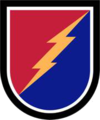 25th Infantry Division, 4th Brigade Combat Team
25th Infantry Division, 4th Brigade Combat Team 25th Infantry Division, 4th Brigade Combat Team, 501st Infantry Regiment, 1st Battalion
25th Infantry Division, 4th Brigade Combat Team, 501st Infantry Regiment, 1st Battalion
—formerly 101st Airborne Division, 2nd Brigade 25th Infantry Division, 4th Brigade Combat Team, 509th Infantry Regiment, 3rd Battalion
25th Infantry Division, 4th Brigade Combat Team, 509th Infantry Regiment, 3rd Battalion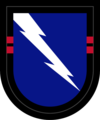
 82nd Airborne Division
82nd Airborne Division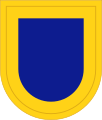 82nd Airborne Division, 1st Brigade Combat Team
82nd Airborne Division, 1st Brigade Combat Team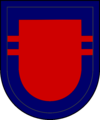 82nd Airborne Division, 1st Brigade Combat Team, 501st Infantry Regiment, 2nd Battalion
82nd Airborne Division, 1st Brigade Combat Team, 501st Infantry Regiment, 2nd Battalion- 82nd Airborne Division, 1st Brigade Combat Team, 504th Infantry Regiment, 1st Battalion
 82nd Airborne Division, 1st Brigade Combat Team, 504th Infantry Regiment, 2nd Battalion
82nd Airborne Division, 1st Brigade Combat Team, 504th Infantry Regiment, 2nd Battalion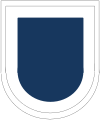 82nd Airborne Division, 2nd Brigade Combat Team
82nd Airborne Division, 2nd Brigade Combat Team 82nd Aiirborne Division, 2nd Brigade Combat Team, 325th Infantry Regiment, 1st Battalion
82nd Aiirborne Division, 2nd Brigade Combat Team, 325th Infantry Regiment, 1st Battalion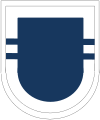 82nd Airborne Division, 2nd Brigade Combat Team, 325th Infantry Regiment, 2nd Battalion
82nd Airborne Division, 2nd Brigade Combat Team, 325th Infantry Regiment, 2nd Battalion 82nd Airborne Division, 2nd Brigade Combat Team, 508th Infantry Regiment, 2nd Battalion
82nd Airborne Division, 2nd Brigade Combat Team, 508th Infantry Regiment, 2nd Battalion
—formerly 4th Brigade Combat Team 82nd Airborne Division, 3rd Brigade Combat Team
82nd Airborne Division, 3rd Brigade Combat Team 82nd Airborne Division, 505th Infantry Regiment, 1st Battalion
82nd Airborne Division, 505th Infantry Regiment, 1st Battalion 82nd Airborne Division, 3rd Brigade Combat Team, 505th Infantry Regiment, 2nd Battalion
82nd Airborne Division, 3rd Brigade Combat Team, 505th Infantry Regiment, 2nd Battalion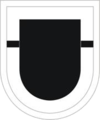 82nd Airborne Division, 3rd Brigade Combat Team, 508th Infantry Regiment, 1st Battalion
82nd Airborne Division, 3rd Brigade Combat Team, 508th Infantry Regiment, 1st Battalion
—formerly 4th Brigade Combat Team
- Obsolete
 Puerto Rico Army National Guard, 92nd Infantry Brigade
Puerto Rico Army National Guard, 92nd Infantry Brigade Texas Army National Guard, 36th Airborne Brigade
Texas Army National Guard, 36th Airborne Brigade Texas Army National Guard, 36th Airborne Brigade, 143rd Infantry Regiment, 1st Battalion
Texas Army National Guard, 36th Airborne Brigade, 143rd Infantry Regiment, 1st Battalion Texas Army National Guard, 36th Airborne Brigade, 143rd Infantry Regiment, 2nd Battalion
Texas Army National Guard, 36th Airborne Brigade, 143rd Infantry Regiment, 2nd Battalion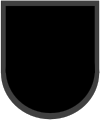 –US Army Alaska, 172nd Infantry Brigade (original version)
–US Army Alaska, 172nd Infantry Brigade (original version)
–101st Airborne Division, Screaming Eagle Replacement Training School US Army Alaska, 172nd Infantry Brigade
US Army Alaska, 172nd Infantry Brigade US Army Alaska, 172nd Infantry Brigade, 9th Infantry Regiment, 4th Battalion
US Army Alaska, 172nd Infantry Brigade, 9th Infantry Regiment, 4th Battalion US Army Alaska, 172nd Infantry Brigade, 23rd Infantry Regiment, 4th Battalion
US Army Alaska, 172nd Infantry Brigade, 23rd Infantry Regiment, 4th Battalion
—redesignated 327th Infantry Regiment, 5th Battalion, Company C (original version)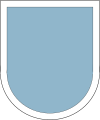 US Army Alaska, 172nd Infantry Brigade, 60th Infantry Regiment, 1st Battalion
US Army Alaska, 172nd Infantry Brigade, 60th Infantry Regiment, 1st Battalion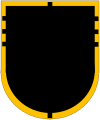 US Army Alaska, 172nd Infantry Brigade, 327th Infantry Regiment, 4th Battalion, Company C
US Army Alaska, 172nd Infantry Brigade, 327th Infantry Regiment, 4th Battalion, Company C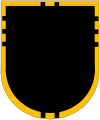 US Army Alaska, 172nd Infantry Brigade, 327th Infantry Regiment, 5th Battalion, Company C
US Army Alaska, 172nd Infantry Brigade, 327th Infantry Regiment, 5th Battalion, Company C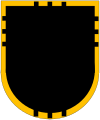 US Army Alaska, 172nd Infantry Brigade, 327th Infantry Regiment, 6th Battalion, Company C
US Army Alaska, 172nd Infantry Brigade, 327th Infantry Regiment, 6th Battalion, Company C US Army South, 193rd Infantry Brigade, 5th Infantry Regiment, 3rd Battalion, Company A
US Army South, 193rd Infantry Brigade, 5th Infantry Regiment, 3rd Battalion, Company A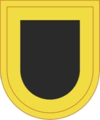 US Army Southern European Task Force (SETAF), 509th Infantry Regiment, 1st Battalion (original version)
US Army Southern European Task Force (SETAF), 509th Infantry Regiment, 1st Battalion (original version) USASOC, 75th Ranger Regiment (original version)
USASOC, 75th Ranger Regiment (original version) USASOC, 75th Ranger Regiment, 1st Battalion (original version)
USASOC, 75th Ranger Regiment, 1st Battalion (original version)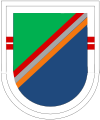 USASOC, 75th Ranger Regiment, 2nd Battalion (original version)
USASOC, 75th Ranger Regiment, 2nd Battalion (original version)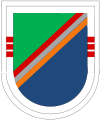 USASOC, 75th Ranger Regiment, 3rd Battalion (original version)
USASOC, 75th Ranger Regiment, 3rd Battalion (original version) 82nd Airborne Division, 1st Brigade Combat Team (original version)
82nd Airborne Division, 1st Brigade Combat Team (original version)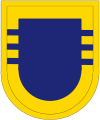 82nd Airborne Division, 1st Brigade Combat Team, 504th Infantry Regiment, 3rd Battalion
82nd Airborne Division, 1st Brigade Combat Team, 504th Infantry Regiment, 3rd Battalion 82nd Airborne Division, 2nd Brigade Combat Team (original version)
82nd Airborne Division, 2nd Brigade Combat Team (original version)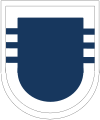 –82nd Airborne Division, 2nd Brigade Combat Team, 325th Infantry Regiment, 3rd Battalion
–82nd Airborne Division, 2nd Brigade Combat Team, 325th Infantry Regiment, 3rd Battalion
–SETAF, 325th Infantry Regiment, 3rd Battalion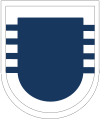 82nd Airborne Division, 2nd Brigade Combat Team, 325th Infantry Regiment, 4th Battalion
82nd Airborne Division, 2nd Brigade Combat Team, 325th Infantry Regiment, 4th Battalion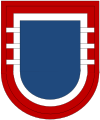 82nd Airborne Division, 3rd Brigade Combat Team (original version)
82nd Airborne Division, 3rd Brigade Combat Team (original version) 82nd Airborne Division, 3rd Brigade Combat Team, 505th Infantry Regiment, 3rd Battalion
82nd Airborne Division, 3rd Brigade Combat Team, 505th Infantry Regiment, 3rd Battalion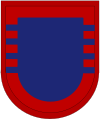 82nd Airborne Division, 3rd Brigade Combat Team, 505th Infantry Regiment, 4th Battalion
82nd Airborne Division, 3rd Brigade Combat Team, 505th Infantry Regiment, 4th Battalion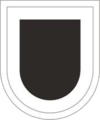 82nd Airborne Division, 4th Brigade Combat Team
82nd Airborne Division, 4th Brigade Combat Team 101st Airborne Division
101st Airborne Division 101st Airborne Division, 1st Brigade
101st Airborne Division, 1st Brigade 101st Airborne Division, 1st Brigade, 327th Infantry Regiment, 1st Battalion
101st Airborne Division, 1st Brigade, 327th Infantry Regiment, 1st Battalion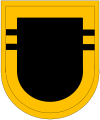 101st Airborne Division, 1st Brigade, 327th Infantry Regiment, 2nd Battalion
101st Airborne Division, 1st Brigade, 327th Infantry Regiment, 2nd Battalion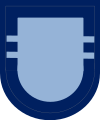 101st Airborne Division, 1st Brigade, 502nd Infantry Regiment, 2nd Battalion
101st Airborne Division, 1st Brigade, 502nd Infantry Regiment, 2nd Battalion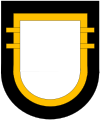 101st Airborne Division, 2nd Brigade
101st Airborne Division, 2nd Brigade 101st Airborne Division, 2nd Brigade, 502nd Infantry Regiment, 1st Battalion
101st Airborne Division, 2nd Brigade, 502nd Infantry Regiment, 1st Battalion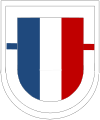 101st Airborne Division, 2nd Brigade, 506th Infantry Regiment, 1st Battalion
101st Airborne Division, 2nd Brigade, 506th Infantry Regiment, 1st Battalion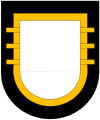 101st Airborne Division, 3rd Brigade
101st Airborne Division, 3rd Brigade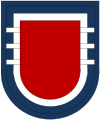 101st Airborne Division, 3rd Brigade, 187th Infantry Regiment, 3rd Battalion
101st Airborne Division, 3rd Brigade, 187th Infantry Regiment, 3rd Battalion
Logistics[]
 Arctic Support Command, 17th Combat Sustainment Support Battalion (CSSB), 4th Quartermaster Detachment
Arctic Support Command, 17th Combat Sustainment Support Battalion (CSSB), 4th Quartermaster Detachment Defense Logistics Agency, Defense Distribution Depot–Army Element
Defense Logistics Agency, Defense Distribution Depot–Army Element General Lucius D. Clay National Guard Center, 165th Quartermaster Company
General Lucius D. Clay National Guard Center, 165th Quartermaster Company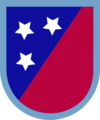 Program Executive Office, Airborne Procurement Team
Program Executive Office, Airborne Procurement Team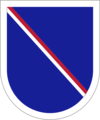 US Army Test and Evaluation Command, Yuma Proving Ground, Airborne Test Force
US Army Test and Evaluation Command, Yuma Proving Ground, Airborne Test Force US Army Test and Evaluation Command, Airborne and Special Operations Test Directorate
US Army Test and Evaluation Command, Airborne and Special Operations Test Directorate
—formerly US Army Airborne Board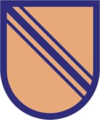 3rd Expeditionary Sustainment Command, 264th CSSB, 647th Quartermaster Company
3rd Expeditionary Sustainment Command, 264th CSSB, 647th Quartermaster Company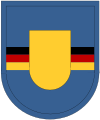 21st Theater Sustainment Command, 16th Sustainment Brigade, 16th Special Troops Battalion, 5th Quartermaster Theater Aerial Delivery Company
21st Theater Sustainment Command, 16th Sustainment Brigade, 16th Special Troops Battalion, 5th Quartermaster Theater Aerial Delivery Company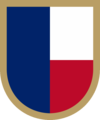 36th Infantry Division, 36th Infantry Division Sustainment Brigade, 294th Quartermaster Company
36th Infantry Division, 36th Infantry Division Sustainment Brigade, 294th Quartermaster Company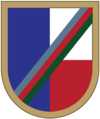 36th Infantry Division, 36th Infantry Division Sustainment Brigade, 294th Quartermaster Company, 36th Quartermaster Detachment
36th Infantry Division, 36th Infantry Division Sustainment Brigade, 294th Quartermaster Company, 36th Quartermaster Detachment 56th Troop Command, 56th Quartermaster Detachment
56th Troop Command, 56th Quartermaster Detachment 82nd Airborne Division, 82nd Airborne Division Sustainment Brigade, 189th CSSB, 11th Quartermaster Company
82nd Airborne Division, 82nd Airborne Division Sustainment Brigade, 189th CSSB, 11th Quartermaster Company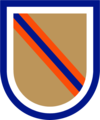 143rd Sustainment Command, 518th Sustainment Brigade, 275th CSSB, 470th Quartermaster Company
143rd Sustainment Command, 518th Sustainment Brigade, 275th CSSB, 470th Quartermaster Company 143rd Sustainment Command, 518th Sustainment Brigade, 275th CSSB, 824th Quartermaster Company
143rd Sustainment Command, 518th Sustainment Brigade, 275th CSSB, 824th Quartermaster Company 143rd Sustainment Command, 518th Sustainment Brigade, 352nd CSSB, 346th Quartermaster Company
143rd Sustainment Command, 518th Sustainment Brigade, 352nd CSSB, 346th Quartermaster Company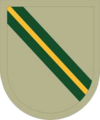 143rd Sustainment Command, 518th Sustainment Brigade, 352nd CSSB, 421st Quartermaster Company
143rd Sustainment Command, 518th Sustainment Brigade, 352nd CSSB, 421st Quartermaster Company 316th Sustainment Command, 77th Sustainment Brigade, 861st Quartermaster Company
316th Sustainment Command, 77th Sustainment Brigade, 861st Quartermaster Company
- Obsolete
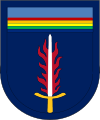 US Army Europe, 29th Transportation Battalion
US Army Europe, 29th Transportation Battalion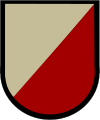 US Army Forces Command, 561st Maintenance Battalion
US Army Forces Command, 561st Maintenance Battalion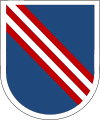 US Army Japan, 10th Regional Support Group, 35th CSSB, 87th Quartermaster Detachment
US Army Japan, 10th Regional Support Group, 35th CSSB, 87th Quartermaster Detachment 1st Cavalry Division Support Command, 15th Support and Transport Battalion (original version)
1st Cavalry Division Support Command, 15th Support and Transport Battalion (original version)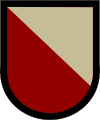 1st Cavalry Division Support Command, 15th Support and Transport Battalion
1st Cavalry Division Support Command, 15th Support and Transport Battalion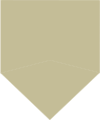 1st Cavalry Division Support Command, 15th Support and Transport Battalion, Company A
1st Cavalry Division Support Command, 15th Support and Transport Battalion, Company A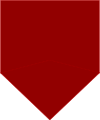 1st Cavalry Division Support Command, 15th Support and Transport Battalion, Company B
1st Cavalry Division Support Command, 15th Support and Transport Battalion, Company B 1st Cavalry Division Support Command, 27th Maintenance Battalion
1st Cavalry Division Support Command, 27th Maintenance Battalion 1st Cavalry Division, 1st Cavalry Division Sustainment Brigade, 527th Quartermaster Detachment
1st Cavalry Division, 1st Cavalry Division Sustainment Brigade, 527th Quartermaster Detachment 1st Corps Support Command, 600th Quartermaster Company
1st Corps Support Command, 600th Quartermaster Company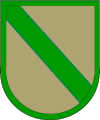 1st Corps Support Command, 612th Quartermaster Company
1st Corps Support Command, 612th Quartermaster Company 1st Corps Support Command, 623rd Quartermaster Company
1st Corps Support Command, 623rd Quartermaster Company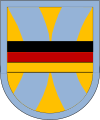 21st Theater Sustainment Command, 16th Sustainment Brigade, 16th Special Troops Battalion, 5th Quartermaster Theater Aerial Delivery Company (original version)
21st Theater Sustainment Command, 16th Sustainment Brigade, 16th Special Troops Battalion, 5th Quartermaster Theater Aerial Delivery Company (original version)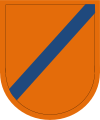 82nd Airborne Division, 33rd Aviation Maintenance Company
82nd Airborne Division, 33rd Aviation Maintenance Company 82nd Airborne Division, 407th Supply and Transportation Battalion
82nd Airborne Division, 407th Supply and Transportation Battalion
—currently 82nd Airborne Division, 2nd Brigade Combat Team, 407th Brigade Support Battalion 82nd Airborne Division, 4th Brigade Combat Team, 782nd Maintenance Battalion
82nd Airborne Division, 4th Brigade Combat Team, 782nd Maintenance Battalion
—redesignated 782nd Brigade Support Battalion 451st Expeditionary Sustainment Command, 89th Sustainment Brigade, 620th CSSB, 383rd Quartermaster Company
451st Expeditionary Sustainment Command, 89th Sustainment Brigade, 620th CSSB, 383rd Quartermaster Company
Medical[]
Some beret flashes in this sub–section may be obsolete; more information is needed. |
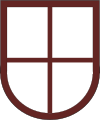 USAREUR–AF, 30th Medical Brigade, 212th Combat Support Hospital, 67th Forward Resuscitative and Surgical Detachment (FRSD)
USAREUR–AF, 30th Medical Brigade, 212th Combat Support Hospital, 67th Forward Resuscitative and Surgical Detachment (FRSD)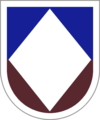 XVIII Airborne Corps, 44th Medical Brigade, 28th Combat Support Hospital, 240th FRSD
XVIII Airborne Corps, 44th Medical Brigade, 28th Combat Support Hospital, 240th FRSD XVIII Airborne Corps, 44th Medical Brigade, 28th Combat Support Hospital, 274th FRSD
XVIII Airborne Corps, 44th Medical Brigade, 28th Combat Support Hospital, 274th FRSD XVIII Airborne Corps, 44th Medical Brigade, 28th Combat Support Hospital, 541st FRSD
XVIII Airborne Corps, 44th Medical Brigade, 28th Combat Support Hospital, 541st FRSD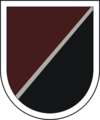 XVIII Airborne Corps, 44th Medical Brigade, 28th Combat Support Hospital, 759th FRSD
XVIII Airborne Corps, 44th Medical Brigade, 28th Combat Support Hospital, 759th FRSD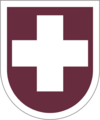 18th Medical Command, 8th FRSD
18th Medical Command, 8th FRSD 593rd Expeditionary Sustainment Command, 62nd Medical Brigade, 47th Combat Support Hospital, 250th FRSD
593rd Expeditionary Sustainment Command, 62nd Medical Brigade, 47th Combat Support Hospital, 250th FRSD
- Obsolete
 US Army Forces Command, 86th Combat Support Hospital
US Army Forces Command, 86th Combat Support Hospital 1st Cavalry Division Support Command, 15th Medical Battalion (original version)
1st Cavalry Division Support Command, 15th Medical Battalion (original version)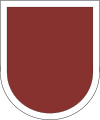 1st Cavalry Division Support Command, 15th Medical Battalion
1st Cavalry Division Support Command, 15th Medical Battalion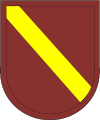 4th Infantry Division, 4th Medical Battalion, Company C
4th Infantry Division, 4th Medical Battalion, Company C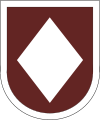 XVIII Airborne Corps, 44th Medical Brigade
XVIII Airborne Corps, 44th Medical Brigade 82nd Airborne Division, 307th Medical Battalion
82nd Airborne Division, 307th Medical Battalion
—currently 82nd Airborne Division, 1st Brigade Combat Team, 307th Brigade Support Battalion 593rd Expeditionary Sustainment Command, 62nd Medical Brigade, 47th Combat Support Hospital, 250th Medical Detachment
593rd Expeditionary Sustainment Command, 62nd Medical Brigade, 47th Combat Support Hospital, 250th Medical Detachment
Military intelligence[]
 1st Special Forces Command, 528th Sustainment Brigade, 389th Military Intelligence Battalion
1st Special Forces Command, 528th Sustainment Brigade, 389th Military Intelligence Battalion
- Obsolete
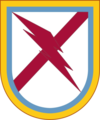 Alabama Army National Guard, 142nd Battlefield Surveillance Brigade (BfSB), 131st Cavalry Regiment, 1st Squadron, Troop C (Long–Range Surveillance (LRS))
Alabama Army National Guard, 142nd Battlefield Surveillance Brigade (BfSB), 131st Cavalry Regiment, 1st Squadron, Troop C (Long–Range Surveillance (LRS))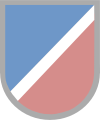 Georgia Army National Guard, 560th BfSB, 108th Cavalry Regiment, 3rd Squadron, 121st Infantry, Company H (LRS)
Georgia Army National Guard, 560th BfSB, 108th Cavalry Regiment, 3rd Squadron, 121st Infantry, Company H (LRS)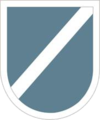 Indiana Army National Guard, 219th BfSB, 152nd Cavalry Regiment, 2nd Squadron, Troop C (LRS)
Indiana Army National Guard, 219th BfSB, 152nd Cavalry Regiment, 2nd Squadron, Troop C (LRS)
—redesignated 38th Infantry Division, 151st Infantry Regiment, Company D (LRS) Maryland Army National Guard, 58th BfSB, 158th Cavalry Regiment, 1st Squadron, Troop C (LRS)
Maryland Army National Guard, 58th BfSB, 158th Cavalry Regiment, 1st Squadron, Troop C (LRS)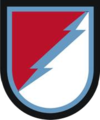 Texas Army National Guard, 71st BfSB, 124th Cavalry Regiment, 3rd Squadron, Troop C (LRS)
Texas Army National Guard, 71st BfSB, 124th Cavalry Regiment, 3rd Squadron, Troop C (LRS)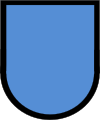 Texas Army National Guard, 1136th Infantry Detachment (LRS)
Texas Army National Guard, 1136th Infantry Detachment (LRS) US Army Alaska, 207th Infantry Group, LRS Detachment
US Army Alaska, 207th Infantry Group, LRS Detachment US Army Europe, 66th Military Intelligence Brigade, 105th Military Intelligence Battalion, LRS Detachment
US Army Europe, 66th Military Intelligence Brigade, 105th Military Intelligence Battalion, LRS Detachment USAREUR–AF, 173rd Airborne Brigade, 74th Infantry Detachment (LRS)
USAREUR–AF, 173rd Airborne Brigade, 74th Infantry Detachment (LRS) –US Army Forces Command, 313th Army Security Agency Battalion, 265th Army Security Agency Company
–US Army Forces Command, 313th Army Security Agency Battalion, 265th Army Security Agency Company
–82nd Airborne Division, 313th Military Intelligence Battalion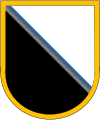 US Army South, 470th Military Intelligence Brigade, 14th Military Intelligence Battalion, Company C (LRS)
US Army South, 470th Military Intelligence Brigade, 14th Military Intelligence Battalion, Company C (LRS)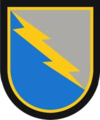
 I Corps, 201st BfSB, 38th Cavalry Regiment, 3rd Squadron, Troop C (LRS)
I Corps, 201st BfSB, 38th Cavalry Regiment, 3rd Squadron, Troop C (LRS) I Corps, 201st BfSB, 109th Military Intelligence Battalion, 52nd Infantry Regiment, Company C (LRS)
I Corps, 201st BfSB, 109th Military Intelligence Battalion, 52nd Infantry Regiment, Company C (LRS)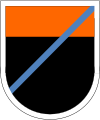 1st Cavalry Division, 312th Military Intelligence Battalion, LRS Detachment
1st Cavalry Division, 312th Military Intelligence Battalion, LRS Detachment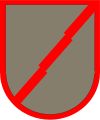 1st Infantry Division, 101st Military Intelligence Battalion, Company D, LRS Detachment
1st Infantry Division, 101st Military Intelligence Battalion, Company D, LRS Detachment –1st Special Forces, 297th Military Intelligence Detachment
–1st Special Forces, 297th Military Intelligence Detachment
–XVIII Airborne Corps, 525th Military Intelligence Brigade, 337th Military Intelligence Battalion 2nd Armored Division, 303rd Army Security Agency Battalion
2nd Armored Division, 303rd Army Security Agency Battalion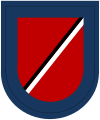 2nd Infantry Division, 2nd Division Support Group, 102nd Military Intelligence Battalion, LRS Detachment
2nd Infantry Division, 2nd Division Support Group, 102nd Military Intelligence Battalion, LRS Detachment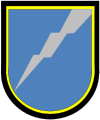 III Corps, 504th BfSB, 38th Cavalry Regiment, 2nd Squadron, Troop C (LRS) (original version)
III Corps, 504th BfSB, 38th Cavalry Regiment, 2nd Squadron, Troop C (LRS) (original version) III Corps, 504th BfSB, 38th Cavalry Regiment, 2nd Squadron, Troop C (LRS)
III Corps, 504th BfSB, 38th Cavalry Regiment, 2nd Squadron, Troop C (LRS) III Corps, 504th Military Intelligence Brigade, 163rd Military Intelligence Battalion, LRS Detachment (original version)
III Corps, 504th Military Intelligence Brigade, 163rd Military Intelligence Battalion, LRS Detachment (original version) III Corps, 504th Military Intelligence Brigade, 163rd Military Intelligence Battalion, LRS Detachment
III Corps, 504th Military Intelligence Brigade, 163rd Military Intelligence Battalion, LRS Detachment 3rd Infantry Division, 103rd Military Intelligence Battalion, LRS Detachment
3rd Infantry Division, 103rd Military Intelligence Battalion, LRS Detachment 4th Infantry Division, 104th Military Intelligence Battalion, LRS Detachment
4th Infantry Division, 104th Military Intelligence Battalion, LRS Detachment –V Corps, 205th BfSB, 51st Infantry Regiment, Company E (LRS)
–V Corps, 205th BfSB, 51st Infantry Regiment, Company E (LRS)
–XVIII Airborne Corps, 525th BfSB, 51st Infantry Regiment, Company F (LRS)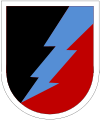 6th Infantry Division, 106th Military Intelligence Battalion, Company C, LRS Detachment
6th Infantry Division, 106th Military Intelligence Battalion, Company C, LRS Detachment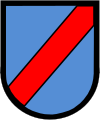 7th Infantry Division, 107th Military Intelligence Battalion, LRS Detachment
7th Infantry Division, 107th Military Intelligence Battalion, LRS Detachment 8th Infantry Division, 108th Military Intelligence Battalion, LRS Detachment
8th Infantry Division, 108th Military Intelligence Battalion, LRS Detachment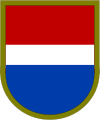 9th Infantry Division, 109th Military Intelligence Battalion, Company E, LRS Detachment
9th Infantry Division, 109th Military Intelligence Battalion, Company E, LRS Detachment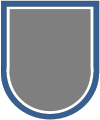 10th Mountain Division, 110th Military Intelligence Battalion, LRS Detachment
10th Mountain Division, 110th Military Intelligence Battalion, LRS Detachment XVIII Airborne Corps, 525th Military Intelligence Brigade
XVIII Airborne Corps, 525th Military Intelligence Brigade
—formerly 525th BfSB XVIII Airborne Corps, 525th BfSB, 38th Cavalry Regiment, 1st Squadron, Troop C (LRS)
XVIII Airborne Corps, 525th BfSB, 38th Cavalry Regiment, 1st Squadron, Troop C (LRS) 24th Infantry Division, 124th Military Intelligence Battalion, LRS Detachment
24th Infantry Division, 124th Military Intelligence Battalion, LRS Detachment 25th Infantry Division, LRS Detachment
25th Infantry Division, LRS Detachment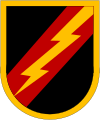 25th Infantry Division, 125th Military Intelligence Battalion, LRS Detachment
25th Infantry Division, 125th Military Intelligence Battalion, LRS Detachment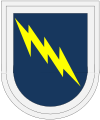 26th Infantry Division, 173rd Infantry Detachment (LRS)
26th Infantry Division, 173rd Infantry Detachment (LRS)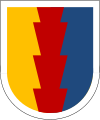 28th Infantry Division, 104th Infantry Detachment (LRS) (original version)
28th Infantry Division, 104th Infantry Detachment (LRS) (original version) 28th Infantry Division, 104th Infantry Detachment (LRS)
28th Infantry Division, 104th Infantry Detachment (LRS) –47th Infantry Division, 194th Infantry Detachment (LRS)
–47th Infantry Division, 194th Infantry Detachment (LRS)
–34th Infantry Division, 194th Infantry Detachment (LRS) 35th Infantry Division, 167th Cavalry Regiment, 1st Squadron, LRS Detachment
35th Infantry Division, 167th Cavalry Regiment, 1st Squadron, LRS Detachment 40th Infantry Division, 79th Brigade Combat Team, 18th Cavalry Regiment, 1st Squadron, LRS Detachment
40th Infantry Division, 79th Brigade Combat Team, 18th Cavalry Regiment, 1st Squadron, LRS Detachment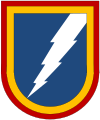 42nd Infantry Division, 27th Brigade Combat Team, 101st Cavalry Regiment, 2nd Squadron, LRS Detachment
42nd Infantry Division, 27th Brigade Combat Team, 101st Cavalry Regiment, 2nd Squadron, LRS Detachment 42nd Infantry Division, 117th Cavalry Regiment, 5th Squadron, LRS Detachment
42nd Infantry Division, 117th Cavalry Regiment, 5th Squadron, LRS Detachment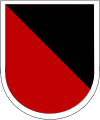 101st Airborne Division, 311th Military Intelligence Battalion, LRS Detachment
101st Airborne Division, 311th Military Intelligence Battalion, LRS Detachment
Military police[]
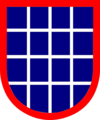 US Army Criminal Investigation Command, 3rd Military Police (MP) Group, 10th MP Battalion
US Army Criminal Investigation Command, 3rd Military Police (MP) Group, 10th MP Battalion XVIII Airborne Corps, 16th MP Brigade
XVIII Airborne Corps, 16th MP Brigade XVIII Airborne Corps, 16th MP Brigade, 503rd MP Battalion, 21st MP Company
XVIII Airborne Corps, 16th MP Brigade, 503rd MP Battalion, 21st MP Company XVIII Airborne Corps, 16th MP Brigade, 503rd MP Battalion, 65th MP Company
XVIII Airborne Corps, 16th MP Brigade, 503rd MP Battalion, 65th MP Company XVIII Airborne Corps, 16th MP Brigade, 503rd MP Battalion, 108th MP Company
XVIII Airborne Corps, 16th MP Brigade, 503rd MP Battalion, 108th MP Company XVIII Airborne Corps, 16th MP Brigade, 503rd MP Battalion, 118th MP Company
XVIII Airborne Corps, 16th MP Brigade, 503rd MP Battalion, 118th MP Company
- Obsolete
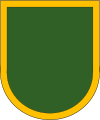 US Army Alaska, Fort Wainwright, 472nd MP Company
US Army Alaska, Fort Wainwright, 472nd MP Company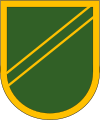 –US Army Forces Command, 553rd MP Company
–US Army Forces Command, 553rd MP Company
–101st Airborne Division, 101st MP Company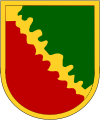 XVIII Airborne Corps, 16th MP Group
XVIII Airborne Corps, 16th MP Group
Multidisciplinary units[]
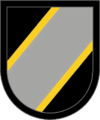 Joint Special Operations Command (JSOC)–Army Element
Joint Special Operations Command (JSOC)–Army Element Special Operations Command Africa–Army Element
Special Operations Command Africa–Army Element Special Operations Command Central–Army Element
Special Operations Command Central–Army Element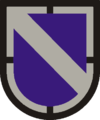 Special Operations Command Europe–Army Element
Special Operations Command Europe–Army Element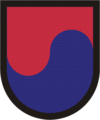 Special Operations Command Korea–Army Element
Special Operations Command Korea–Army Element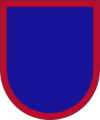 Special Operations Command North–Army Element
Special Operations Command North–Army Element Special Operations Command Pacific–Army Element
Special Operations Command Pacific–Army Element Special Operations Command South–Army Element
Special Operations Command South–Army Element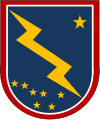 US Army Alaska, Early–Entry Command Post
US Army Alaska, Early–Entry Command Post USACAPOC
USACAPOC USAREUR–AF, 173rd Airborne Brigade, 173rd Brigade Support Battalion
USAREUR–AF, 173rd Airborne Brigade, 173rd Brigade Support Battalion US Army Futures Command
US Army Futures Command USASOC
USASOC US Southern Command, Joint Task Force Bravo
US Southern Command, Joint Task Force Bravo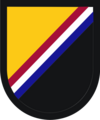 US Special Operations Command–Army Element
US Special Operations Command–Army Element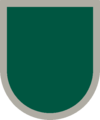 1st Special Forces Command
1st Special Forces Command
—formerly 1st Special Forces 1st Special Forces Command, 528th Sustainment Brigade
1st Special Forces Command, 528th Sustainment Brigade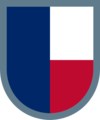 1st Special Forces Command, 528th Sustainment Brigade, Special Troops Battalion, 197th Special Troops Support Company
1st Special Forces Command, 528th Sustainment Brigade, Special Troops Battalion, 197th Special Troops Support Company- XVIII Airborne Corps
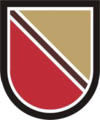 25th Infantry Division, 4th Brigade Combat Team, 725th Brigade Support Battalion
25th Infantry Division, 4th Brigade Combat Team, 725th Brigade Support Battalion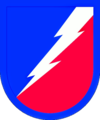 82nd Airborne Division, 82nd Airborne Division Sustainment Brigade
82nd Airborne Division, 82nd Airborne Division Sustainment Brigade 82nd Airborne Division, 1st Brigade Combat Team, 307th Brigade Support Battalion
82nd Airborne Division, 1st Brigade Combat Team, 307th Brigade Support Battalion
—formerly 82nd Airborne Division, 307th Medical Battalion 82nd Airborne Division, 2nd Brigade Combat Team, 407th Brigade Support Battalion
82nd Airborne Division, 2nd Brigade Combat Team, 407th Brigade Support Battalion
—formerly 82nd Airborne Division, 407th Supply and Transportation Battalion 82nd Airborne Division, 3rd Brigade Combat Team, 82nd Brigade Support Battalion
82nd Airborne Division, 3rd Brigade Combat Team, 82nd Brigade Support Battalion 82nd Airborne Division, Combat Aviation Brigade, 122nd Aviation Support Battalion
82nd Airborne Division, Combat Aviation Brigade, 122nd Aviation Support Battalion
- Obsolete
 Puerto Rico Army National Guard Headquarters, Command and Control
Puerto Rico Army National Guard Headquarters, Command and Control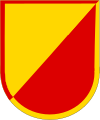 Puerto Rico Army National Guard Headquarters
Puerto Rico Army National Guard Headquarters
—currently Puerto Rico State Guard Puerto Rico Army National Guard, 292nd Area Command
Puerto Rico Army National Guard, 292nd Area Command Special Operations Command Joint Forces–Army Element
Special Operations Command Joint Forces–Army Element Special Operations Task Force Europe–Army Element
Special Operations Task Force Europe–Army Element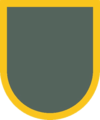 Supreme Headquarters Allied Powers Europe, Special Projects Branch–Army Element
Supreme Headquarters Allied Powers Europe, Special Projects Branch–Army Element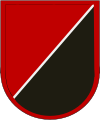 US Army Europe, 173rd Airborne Brigade, Combat Support Battalion
US Army Europe, 173rd Airborne Brigade, Combat Support Battalion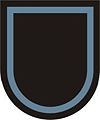 US Army Europe, 173rd Airborne Brigade, Special Troops Battalion
US Army Europe, 173rd Airborne Brigade, Special Troops Battalion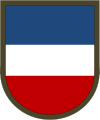 US Army Forces Command
US Army Forces Command US Army Forces Command, Joint Task Force Deployable
US Army Forces Command, Joint Task Force Deployable US Army Garrison, Fort Bragg
US Army Garrison, Fort Bragg US Army Reserve Special Operations Command
US Army Reserve Special Operations Command SETAF
SETAF US Army Special Operations Support Command
US Army Special Operations Support Command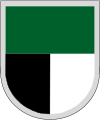 1st Special Operations Command
1st Special Operations Command 1st Sustainment Command
1st Sustainment Command 3rd Special Operations Support Command
3rd Special Operations Support Command 4th Special Operations Support Command
4th Special Operations Support Command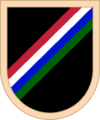 5th Special Operations Support Command
5th Special Operations Support Command 6th Special Operations Support Command
6th Special Operations Support Command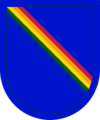 7th Special Operations Support Command
7th Special Operations Support Command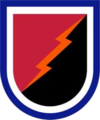 25th Infantry Division, 4th Brigade Combat Team, Special Troops Battalion
25th Infantry Division, 4th Brigade Combat Team, Special Troops Battalion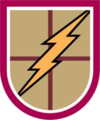 25th Infantry Division, 4th Brigade Combat Team, 167th Brigade Support Battalion
25th Infantry Division, 4th Brigade Combat Team, 167th Brigade Support Battalion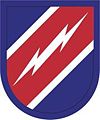 82nd Airborne Division, Special Troops Battalion
82nd Airborne Division, Special Troops Battalion 82nd Airborne Division, 1st Brigade Combat Team, Special Troops Battalion
82nd Airborne Division, 1st Brigade Combat Team, Special Troops Battalion 82nd Airborne Division, 2nd Brigade Combat Team, Special Troops Battalion
82nd Airborne Division, 2nd Brigade Combat Team, Special Troops Battalion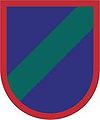 82nd Airborne Division, 3rd Brigade Combat Team, Special Troops Battalion
82nd Airborne Division, 3rd Brigade Combat Team, Special Troops Battalion 82nd Airborne Division, 4th Brigade Combat Team, Special Troops Battalion
82nd Airborne Division, 4th Brigade Combat Team, Special Troops Battalion 82nd Airborne Division, 4th Brigade Combat Team, 782nd Brigade Support Battalion
82nd Airborne Division, 4th Brigade Combat Team, 782nd Brigade Support Battalion
—formerly 782nd Maintenance Battalion 101st Division Support Command (also worn by units at Fort Campbell that lacked an organizational beret flash)
101st Division Support Command (also worn by units at Fort Campbell that lacked an organizational beret flash)
Ordnance[]
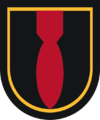 20th Chemical, Biological, Radiological, Nuclear, and Explosives (CBRNE) Command, 52nd Ordnance Group, 192nd Ordnance Battalion, 28th Ordnance Company
20th Chemical, Biological, Radiological, Nuclear, and Explosives (CBRNE) Command, 52nd Ordnance Group, 192nd Ordnance Battalion, 28th Ordnance Company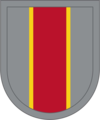 20th CBRNE Command, 52nd Ordnance Group, 192nd Ordnance Battalion, 722nd Ordnance Company
20th CBRNE Command, 52nd Ordnance Group, 192nd Ordnance Battalion, 722nd Ordnance Company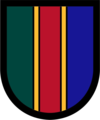 20th CBRNE Command, 52nd Ordnance Group, 192nd Ordnance Battalion, 767th Ordnance Company
20th CBRNE Command, 52nd Ordnance Group, 192nd Ordnance Battalion, 767th Ordnance Company
Psychological operations[]
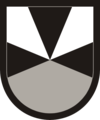 USACAPOC, 2nd Psychological Operations (PSYOPS) Group, 15th PSYOPS Battalion, 310th, 325th, and 346th Tactical PSYOPS Companies
USACAPOC, 2nd Psychological Operations (PSYOPS) Group, 15th PSYOPS Battalion, 310th, 325th, and 346th Tactical PSYOPS Companies USACAPOC, 7th PSYOPS Group, 14th PSYOPS Battalion, 301st Tactical PSYOPS Company
USACAPOC, 7th PSYOPS Group, 14th PSYOPS Battalion, 301st Tactical PSYOPS Company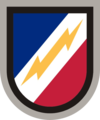 USACAPOC, 7th PSYOPS Group, 17th PSYOPS Battalion, 344th Tactical PSYOPS Company
USACAPOC, 7th PSYOPS Group, 17th PSYOPS Battalion, 344th Tactical PSYOPS Company USACAPOC, 7th PSYOPS Group, 17th PSYOPS Battalion, 345th Tactical PSYOPS Company
USACAPOC, 7th PSYOPS Group, 17th PSYOPS Battalion, 345th Tactical PSYOPS Company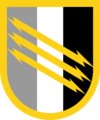 1st Special Forces Command, 4th PSYOPS Group
1st Special Forces Command, 4th PSYOPS Group 1st Special Forces Command, 4th PSYOPS Group, 3rd PSYOPS Battalion
1st Special Forces Command, 4th PSYOPS Group, 3rd PSYOPS Battalion 1st Special Forces Command, 4th PSYOPS Group, 7th PSYOPS Battalion
1st Special Forces Command, 4th PSYOPS Group, 7th PSYOPS Battalion 1st Special Forces Command, 4th PSYOPS Group, 8th PSYOPS Battalion
1st Special Forces Command, 4th PSYOPS Group, 8th PSYOPS Battalion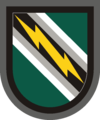 1st Special Forces Command, 8th PSYOPS Group
1st Special Forces Command, 8th PSYOPS Group
- Obsolete
 USACAPOC, 2nd PSYOPS Group, 15th PSYOPS Battalion, 310th Tactical PSYOPS Company (original version)
USACAPOC, 2nd PSYOPS Group, 15th PSYOPS Battalion, 310th Tactical PSYOPS Company (original version)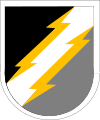 USACAPOC, 2nd PSYOPS Group, 15th PSYOPS Battalion, 325th Tactical PSYOPS Company (original version)
USACAPOC, 2nd PSYOPS Group, 15th PSYOPS Battalion, 325th Tactical PSYOPS Company (original version)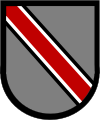 USACAPOC, 2nd PSYOPS Group, 15th PSYOPS Battalion, 346th Tactical PSYOPS Company (original version)
USACAPOC, 2nd PSYOPS Group, 15th PSYOPS Battalion, 346th Tactical PSYOPS Company (original version)
Public affairs[]
 US Army Recruiting Command, Marketing and Engagement Brigade, US Army Parachute Team
US Army Recruiting Command, Marketing and Engagement Brigade, US Army Parachute Team 82nd Airborne Division, 49th Public Affairs Detachment
82nd Airborne Division, 49th Public Affairs Detachment
Signal[]
 JSOC, Joint Communications Unit–Army element
JSOC, Joint Communications Unit–Army element 1st Special Forces Command, 528th Sustainment Brigade, 112th Special Operations Signal Battalion
1st Special Forces Command, 528th Sustainment Brigade, 112th Special Operations Signal Battalion 7th Signal Command, 21st Signal Brigade, 55th Signal Company, Airborne Combat Camera Documentation Team
7th Signal Command, 21st Signal Brigade, 55th Signal Company, Airborne Combat Camera Documentation Team 335th Theater Signal Command, 359th Signal Brigade, 982nd Signal Company, Airborne Platoons
335th Theater Signal Command, 359th Signal Brigade, 982nd Signal Company, Airborne Platoons
- Obsolete
 JSOC, Joint Communications Unit–Army element (original version)
JSOC, Joint Communications Unit–Army element (original version)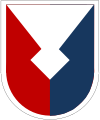 US Army Communications–Electronics Command, Airborne Communications and Electronics Board
US Army Communications–Electronics Command, Airborne Communications and Electronics Board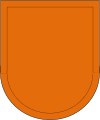 1st Cavalry Division Support Command, 13th Signal Battalion
1st Cavalry Division Support Command, 13th Signal Battalion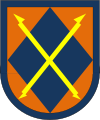 XVIII Airborne Corps, 35th Signal Brigade
XVIII Airborne Corps, 35th Signal Brigade XVIII Airborne Corps, 35th Signal Brigade, 50th Signal Battalion
XVIII Airborne Corps, 35th Signal Brigade, 50th Signal Battalion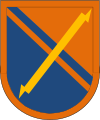 XVIII Airborne Corps, 35th Signal Brigade, 51st Signal Battalion
XVIII Airborne Corps, 35th Signal Brigade, 51st Signal Battalion XVIII Airborne Corps, 35th Signal Brigade, 327th Signal Battalion (original version)
XVIII Airborne Corps, 35th Signal Brigade, 327th Signal Battalion (original version) XVIII Airborne Corps, 35th Signal Brigade, 327th Signal Battalion
XVIII Airborne Corps, 35th Signal Brigade, 327th Signal Battalion XVIII Airborne Corps, 35th Signal Brigade, 426th Signal Battalion
XVIII Airborne Corps, 35th Signal Brigade, 426th Signal Battalion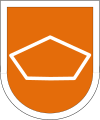 82nd Airborne Division, 82nd Signal Battalion
82nd Airborne Division, 82nd Signal Battalion 101st Airborne Division, 501st Signal Battalion
101st Airborne Division, 501st Signal Battalion 335th Theater Signal Command, 359th Signal Brigade, 982nd Signal Company (original version)
335th Theater Signal Command, 359th Signal Brigade, 982nd Signal Company (original version)
Special forces[]
 Special Forces personnel in non–special forces units
Special Forces personnel in non–special forces units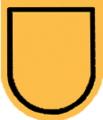 1st Special Forces Command, 1st Special Forces Group
1st Special Forces Command, 1st Special Forces Group 1st Special Forces Command, 1st Special Forces Group, 39th Special Forces Detachment
1st Special Forces Command, 1st Special Forces Group, 39th Special Forces Detachment 1st Special Forces Command, 3rd Special Forces Group
1st Special Forces Command, 3rd Special Forces Group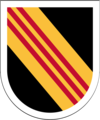 1st Special Forces Command, 5th Special Forces Group
1st Special Forces Command, 5th Special Forces Group
—formerly 5th Special Forces Group–Vietnam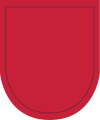 –1st Special Forces Command, 7th Special Forces Group
–1st Special Forces Command, 7th Special Forces Group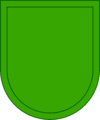 1st Special Forces Command, 10th Special Forces Group
1st Special Forces Command, 10th Special Forces Group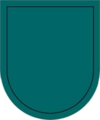 1st Special Forces Command, 19th Special Forces Group
1st Special Forces Command, 19th Special Forces Group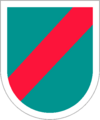 1st Special Forces Command, 20th Special Forces Group
1st Special Forces Command, 20th Special Forces Group
- Obsolete
 Special Forces personnel assigned to the Joint Chiefs of Staff
Special Forces personnel assigned to the Joint Chiefs of Staff 1st Special Forces, Special Forces Reserve
1st Special Forces, Special Forces Reserve 1st Special Forces, Special Forces Reserve Recognition Bar
1st Special Forces, Special Forces Reserve Recognition Bar 1st Special Forces, 1st Special Forces Group Recognition Bar
1st Special Forces, 1st Special Forces Group Recognition Bar 1st Special Forces, 3rd Special Forces Group Recognition Bar
1st Special Forces, 3rd Special Forces Group Recognition Bar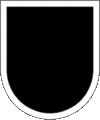 1st Special Forces, 5th Special Forces Group (original version)
1st Special Forces, 5th Special Forces Group (original version) 1st Special Forces, 5th Special Forces Group Recognition Bar
1st Special Forces, 5th Special Forces Group Recognition Bar 1st Special Forces, 5th Special Forces Group–Vietnam Recognition Bar
1st Special Forces, 5th Special Forces Group–Vietnam Recognition Bar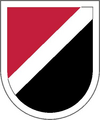 1st Special Forces, 6th Special Forces Group
1st Special Forces, 6th Special Forces Group 1st Special Forces, 6th Special Forces Group Recognition Bar
1st Special Forces, 6th Special Forces Group Recognition Bar 1st Special Forces, 7th Special Forces Group Recognition Bar
1st Special Forces, 7th Special Forces Group Recognition Bar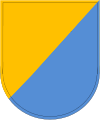 1st Special Forces, 8th Special Forces Group
1st Special Forces, 8th Special Forces Group 1st Special Forces, 8th Special Forces Group Recognition Bar
1st Special Forces, 8th Special Forces Group Recognition Bar 1st Special Forces, 10th Special Forces Group Recognition Bar
1st Special Forces, 10th Special Forces Group Recognition Bar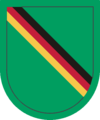 1st Special Forces, 10th Special Forces Group, Special Forces Detachment–Europe
1st Special Forces, 10th Special Forces Group, Special Forces Detachment–Europe 1st Special Forces, 10th Special Forces Group, Special Forces Detachment–Europe Recognition Bar
1st Special Forces, 10th Special Forces Group, Special Forces Detachment–Europe Recognition Bar 1st Special Forces, 11th Special Forces Group
1st Special Forces, 11th Special Forces Group 1st Special Forces, 11th Special Forces Group Recognition Bar
1st Special Forces, 11th Special Forces Group Recognition Bar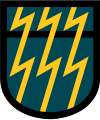 1st Special Forces, 12th Special Forces Group
1st Special Forces, 12th Special Forces Group 1st Special Forces, 12th Special Forces Group Recognition Bar
1st Special Forces, 12th Special Forces Group Recognition Bar 1st Special Forces, 19th Special Forces Group Recognition Bar
1st Special Forces, 19th Special Forces Group Recognition Bar 1st Special Forces, 20th Special Forces Group Recognition Bar
1st Special Forces, 20th Special Forces Group Recognition Bar
Training[]
 Joint Readiness Training Center (JRTC) and Operations Group
Joint Readiness Training Center (JRTC) and Operations Group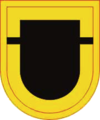 JRTC, 509th Infantry Regiment, 1st Battalion
JRTC, 509th Infantry Regiment, 1st Battalion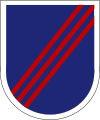 Security Force Assistance Command
Security Force Assistance Command Security Force Assistance Command, 1st SFAB
Security Force Assistance Command, 1st SFAB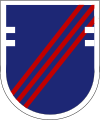 Security Force Assistance Command, 2nd SFAB
Security Force Assistance Command, 2nd SFAB Security Force Assistance Command, 3rd SFAB
Security Force Assistance Command, 3rd SFAB Security Force Assistance Command, 4th SFAB
Security Force Assistance Command, 4th SFAB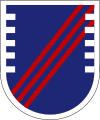 Security Force Assistance Command, 5th SFAB
Security Force Assistance Command, 5th SFAB Security Force Assistance Command, 54th SFAB
Security Force Assistance Command, 54th SFAB US Army Infantry School, Airborne and Ranger Training Brigade
US Army Infantry School, Airborne and Ranger Training Brigade US Army Infantry School, Airborne and Ranger Training Brigade, 507th Infantry Regiment, 1st Battalion
US Army Infantry School, Airborne and Ranger Training Brigade, 507th Infantry Regiment, 1st Battalion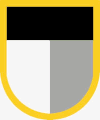 US Army John F. Kennedy Special Warfare Center and School (SWCS)
US Army John F. Kennedy Special Warfare Center and School (SWCS)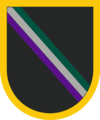 SWCS, David K Thuma NCO Academy
SWCS, David K Thuma NCO Academy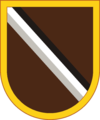 SWCS, Special Forces Warrant Officer Institute
SWCS, Special Forces Warrant Officer Institute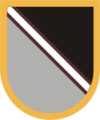 SWCS, Special Warfare Medical Group
SWCS, Special Warfare Medical Group SWCS, 1st Special Warfare Training Group
SWCS, 1st Special Warfare Training Group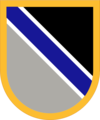 SWCS, 2nd Special Warfare Training Group
SWCS, 2nd Special Warfare Training Group US Army Junior ROTC
US Army Junior ROTC US Army Quartermaster Center and School, 23rd Quartermaster Brigade, 262nd Quartermaster Battalion, Company C
US Army Quartermaster Center and School, 23rd Quartermaster Brigade, 262nd Quartermaster Battalion, Company C US Army Training and Doctrine Command, Airborne/Airlift Action Office
US Army Training and Doctrine Command, Airborne/Airlift Action Office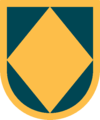 XVIII Airborne Corps, NCO Academy
XVIII Airborne Corps, NCO Academy 82nd Airborne Division, Advanced Airborne School
82nd Airborne Division, Advanced Airborne School
- Obsolete
 Fort Irwin National Training Center, Light Infantry and Task Force Observer/Controller Team
Fort Irwin National Training Center, Light Infantry and Task Force Observer/Controller Team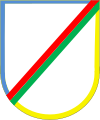 JRTC and Operations Group (original version)
JRTC and Operations Group (original version) North Atlantic Treaty Organization International Long Range Reconnaissance Patrol School–US Army Element
North Atlantic Treaty Organization International Long Range Reconnaissance Patrol School–US Army Element US Army Academy of Health Sciences, Academy Brigade, 3rd Battalion, Company F (Special Forces Medic School)
US Army Academy of Health Sciences, Academy Brigade, 3rd Battalion, Company F (Special Forces Medic School)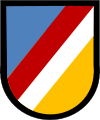 US Army Armor School, Armor Committee Group
US Army Armor School, Armor Committee Group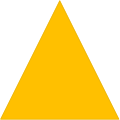 US Army Armor School Instructor
US Army Armor School Instructor US Army Armor School, 1st Armor Training Brigade
US Army Armor School, 1st Armor Training Brigade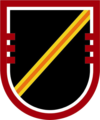 US Army Armor School, 16th Cavalry Regiment, 3rd Squadron, Company D (Reconnaissance and Surveillance Leaders Course)
US Army Armor School, 16th Cavalry Regiment, 3rd Squadron, Company D (Reconnaissance and Surveillance Leaders Course) US Army Armor School, 194th Armored Brigade, 3rd Field Artillery, 3rd Battalion
US Army Armor School, 194th Armored Brigade, 3rd Field Artillery, 3rd Battalion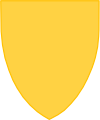 –US Army Armor School, 194th Armored Brigade, 33rd Armor Regiment, 5th Battalion
–US Army Armor School, 194th Armored Brigade, 33rd Armor Regiment, 5th Battalion
–37th Armor Regiment, 4th Battalion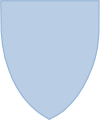 US Army Armor School, 194th Armored Brigade, 54th Infantry Regiment, 4th Battalion
US Army Armor School, 194th Armored Brigade, 54th Infantry Regiment, 4th Battalion US Army Aviation Center and School, 509th Infantry, Company C (Pathfinder)
US Army Aviation Center and School, 509th Infantry, Company C (Pathfinder)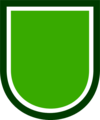 US Army Aviation Center and School, 511th Infantry Regiment, Company A (Pathfinder)
US Army Aviation Center and School, 511th Infantry Regiment, Company A (Pathfinder) US Army Aviation Center and School, 1st Aviation Brigade, 187th Infantry Detachment (Pathfinder)
US Army Aviation Center and School, 1st Aviation Brigade, 187th Infantry Detachment (Pathfinder)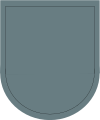 US Army Infantry School, Airborne Department
US Army Infantry School, Airborne Department US Army Infantry School, Ranger Department Recognition Bar
US Army Infantry School, Ranger Department Recognition Bar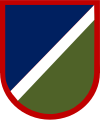 US Army Mountain Warfare School, 172nd Infantry Regiment, 3rd Battalion
US Army Mountain Warfare School, 172nd Infantry Regiment, 3rd Battalion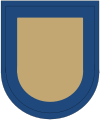 US Army Quartermaster Center and School, Aerial Delivery & Field Services Department
US Army Quartermaster Center and School, Aerial Delivery & Field Services Department US Army School of the Americas' Special Operations and Civil Military Operations Department
US Army School of the Americas' Special Operations and Civil Military Operations Department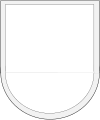 SWCS, Special Forces Training Group
SWCS, Special Forces Training Group SWCS, Special Forces Training Group Recognition Bar
SWCS, Special Forces Training Group Recognition Bar SWCS, Special Warfare Education Group
SWCS, Special Warfare Education Group US Army Junior ROTC
US Army Junior ROTC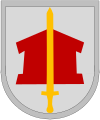 US Army ROTC, Ranger Challenge Team
US Army ROTC, Ranger Challenge Team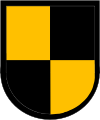 US Army ROTC, Senior Ranger Challenge Team
US Army ROTC, Senior Ranger Challenge Team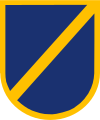 US Army ROTC, Drexel University
US Army ROTC, Drexel University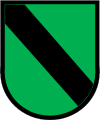 US Army ROTC, Southwest Missouri State University
US Army ROTC, Southwest Missouri State University –US Army ROTC, Temple University
–US Army ROTC, Temple University
–Various cavalry units (see "Armor and cavalry" section)
Note that this is the most prolific organizational beret flash in the US Army. US Army ROTC, University of North Carolina–Chapel Hill
US Army ROTC, University of North Carolina–Chapel Hill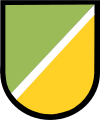 US Army ROTC, University of Puerto Rico– Mayagüez
US Army ROTC, University of Puerto Rico– Mayagüez US Army ROTC, University of Utah, Ute Scouts Ranger Company
US Army ROTC, University of Utah, Ute Scouts Ranger Company US Army ROTC, University of Utah Recognition Bar
US Army ROTC, University of Utah Recognition Bar US Army ROTC, Western Michigan University
US Army ROTC, Western Michigan University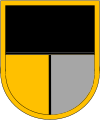 US Military Academy, Airborne Detachment (original version)
US Military Academy, Airborne Detachment (original version) US Military Academy, Airborne Detachment
US Military Academy, Airborne Detachment –101st Airborne Division, Screaming Eagle Replacement Training School
–101st Airborne Division, Screaming Eagle Replacement Training School
–US Army Alaska, 172nd Infantry Brigade (original version)
Beret flashes of US defense forces[]
Collectively referred to as state defense forces—also known as state guard, state military reserve, or militia—in many US states and territories wear modified versions of US Army uniforms.[9][92][93] To help separate these state guard members from other federal armed forces, such as the US National Guard, they will wear a unique organizational beret flash on their military beret that is worn in the same manner as their federal counterparts.[9][94][95][96][97][98][99][100] The following is a list of some of these organizational beret flashes worn by various US militia units:
- State Defense Force (worn by various state reserve units)
State, territory, and district specific militia[]
 California State Guard
California State Guard Maryland Defense Force
Maryland Defense Force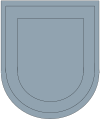 New York Guard
New York Guard Puerto Rico State Guard
Puerto Rico State Guard
—formerly Puerto Rico Army National Guard Headquarters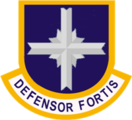 Puerto Rico State Guard, Air Division, 1st Air Base Group, Security Forces
Puerto Rico State Guard, Air Division, 1st Air Base Group, Security Forces Texas State Guard
Texas State Guard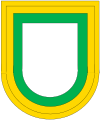 Washington State Guard
Washington State Guard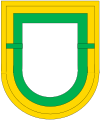 Washington State Guard, 1st Brigade
Washington State Guard, 1st Brigade Washington State Guard, 2nd Brigade
Washington State Guard, 2nd Brigade
- Obsolete
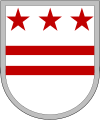 District of Columbia Defense Force
District of Columbia Defense Force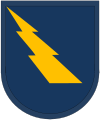 Texas State Guard, 404th Military Police Battalion
Texas State Guard, 404th Military Police Battalion
See also[]
- Uniforms of the United States Army
- Uniforms of the United States Air Force
- Uniforms of the United States Navy
- Badges of the United States Army
- Badges of the United States Air Force
- Obsolete badges of the United States military
References[]
- ^ a b c d e f g h i j k l m n o p q Department of the Army Pamphlet 670–1, Uniform and Insignia Guide to the Wear and Appearance of Army Uniforms and Insignia, Department of the Army, dated 26 January 2021, last accessed 21 June 2021
 This article incorporates text from this source, which is in the public domain.
This article incorporates text from this source, which is in the public domain.
- ^ a b c d e f g h i j k l m Air Force Instruction 36-2903, Dress and Personal Appearance of Air Force Personnel, US Department of the Air Force, dated 7 February 2020, corrected 2 July 2020, last accessed 14 November 2020
- ^ a b c d e f g h i j Beret Insignia of the U.S. Army, by William A Hudspeath, dated 1987, ASIN B06XD7DSY9, last reviewed 1 September 2021
- ^ a b c d e AR 670–1 1981 (OBSOLETE):Wear and appearance of Army uniforms and insignia, Department of the Army via Ike Skelton Combined Arms Research Library Digital Library, dated 1 November 1981, last accessed 21 November 2020
- ^ a b c d US Army / US Army Heraldry / Beret Flash and Background Trimmings, The Institute of Heraldry, last accessed 12 February 2020
- ^ a b Joint Communications Support Element–Government Organization, official Facebook page, last accessed 20 January 2021
- ^ a b War Eagle Troopers receive Multinational Force and Observers medal, Army.mil, by MAJ Michael Soyka and SGT William A. Tanner, dated 9 May 2016, last accessed 28 April 2018
- ^ a b Quiet Professionals don brown beret, US Air Force Special Operations Command, by Capt Monique Roux, dated 8 January 2018, last accessed 28 April 2018
- ^ a b c d e Army Regulation 670–1 (2021), Uniform and Insignia Wear and Appearance of Army Uniforms and Insignia, Department of the Army, dated 26 January 2021, last accessed 11 April 2021
- ^ a b c d e f g h i FAQs-Organizational Insignia, Department of the Army, The Institute of Heraldry, last accessed 20 November 2021
- ^ a b c Big Picture: Your Army Reports: Number 10, US Army's The Big Picture (TV 713), hosted on PublicResourceOrg YouTube Channel, dated 1967, posted 31 December 2010, last accessed 19 May 2020
- ^ Beret Flash and Background Trimming for the 346th Quartermaster Company; Department of the Army, The Institute of Heraldry; SAAA-IHS; dated 16 December 2019; last accessed 6 June 2020
- ^ TIOH Organization, Department of the Army, The Institute of Heraldry, last accessed 7 December 2021
- ^ a b c d All American Legacy Podcast Ep 25 - The French Hat, 82nd Airborne Division Official YouTube Channel, dated 26 June 2017, last accessed 24 March 2020
- ^ a b The colorful and controversial history of the Army's berets, ConnectingVets.Radio.com, by Jack Murphy, dated 23 October 2019, last accessed 18 January 2020
- ^ a b c Rare WWII 509th Parachute Infantry Battalion Airborne Italian Made Patch Superb, Pricing and History, WorthPoint, last accessed 19 October 2021
- ^ a b c d 509th PIB Red Beret, 509th Parachute Infantry Battalion, America's First Combat Paratroopers, History of the 509th PIB in WWII (1941 - 1945), 509th Parachute Infantry Association, dated 2006, last accessed 19 October 2021
- ^ Earning it: A complete history of Army berets and who's allowed to wear them, ArmyTimes, by Meghann Myers, dated 19 November 2017, last accessed 19 October 2021
- ^ a b 509th Infantry Regiment, Distinctive Unit Insignia, Coat of Arms, Department of the Army, The Institute of Heraldry, dated 28 May 1970, last accessed 4 July 2021
- ^ Keith Allen Campbell; Specialist Four; Headquarters and Headquarters Company, 1st Battalion, 503rd Infantry, 173rd Airborne Brigade, US Army Reserve; Army of the United States, Arlington, Virginia; March 03, 1946 to February 08, 1967; The Virtual Wall, Vietnam Veterans Memorial; last updated 15 August 2019, last accessed 14 November 2020
- ^ a b c d e RFK Speech- Authorizations for Green Beret, John F. Kennedy Special Warfare Museum, soc.mil, last accessed 25 April 2021
- ^ a b US Army Special Forces 1952–84, Bloomsbury Publishing, by Gordon L. Rottman, dated 20 September 2012, ISBN 9781782004462, last accessed 29 March 2019
- ^ Army Regulation 614–200, Enlisted Assignments and Utilization Management, Department of the Army, dated 25 January 2019, last accessed 30 May 2020
- ^ a b Utrikestjänst, CA besök i USA. Fort Bragg, Digitaltmuseum.se, by SP4 Laverne Fultz (US Army), dated 28 May 1975, last accessed 19 December 2020
- ^ a b c History of the Army Beret, CSA SENDS - THE ARMY BLACK BERET, armyreal.com, last accessed 12 February 2020
- ^ a b c d e f g h i j k The Beret in U.S. Military Uniform History, The Balance Careers, by Rod Powers, updated 27 June 2019, last accessed 14 September 2019
- ^ a b c d e f g h i j k A Short History of the Use of Berets in the U.S. Army, army.mil via WebArchive, dated 03 November 2000, last accessed 26 March 2019
- ^ a b c d e f g h i j k l m n o p q r s t u v US Army berets - blue, black, green, maroon, tan..., The US Militaria Forum, last accessed 10 September 2021
- ^ A member of Company B, 2nd Brigade, 82nd Airborne Division, prepares for a troop drop during Exercise NEPTUNE II, Defense Audiovisual Agency, National Archives and Records Administration (locator: 6375832 and local identifier: 330-CFD-DF-SN-84-04750.jpeg), dated 20 August 1977, last accessed 19 December 2020
- ^ a b c 101st Airborne Division Blue Air Assault Beret 1973-1978, U.S. Militaria Forum, last accessed 25 January 2021
- ^ Welcome to the 101st Airborne Division (Air Assault), Army.mil, by 101st Airborne Division Public Affairs Office, dated 2 April 2014, last accessed 25 January 20212
- ^ a b c On episode 25 of the All American Legacy Podcast, we mention the blue beret of the 101st Airborne Division in the 1970s. Well, here is the proof., 82nd Airborne Division official Facebook page, dated 28 June 2017, last accessed 27 January 2022
- ^ Qualification Badges, Air Assault Badge, Department of the Army, The Institute of Heraldry, dated 18 January 1978, last accessed 16 October 2020
- ^ a b History of the Black Beret, Army Study Guide, by SMA Jack L. Tilley, last accessed 23 December 2020
- ^ a b 1st Battalion 22nd Infantry, Regulars 76-78, 1st Battalion 22nd Infantry 1976-1978, Image caption: (Photo taken when Don was with the 172nd INF BDE in Alaska, before being assigned to 1/22 Infantry. Note the olive drab beret. The 172nd was the only unit in the Army authorized to wear the olive beret.), by Don Krewson, dated 2011, last accessed 8 May 2021
- ^ a b The Black Beret, Tanker's Jackets and Gunnery Qualification Patches: Scouts Out ... Fashion Forward, The Hidden Stories: 1970s - From Starch to Permanent Press, Eaglehorse.org, last accessed 6 May 2020
- ^ Nick's FARRP #7 – First Cavalry Division – 1978, The Days Forward, dated 14 June 2020, last accessed 5 September 2021
- ^ a b Evolution and Endurance, The U.S. Army Division in the Twentieth Century, RAND Corporation, by Richard W. Kabzior, published 2000, last accessed 25 January 2022
- ^ Ranger Hall of Fame, US Army Airborne and Ranger Training Brigade, last Updated 28 November 2018, last accessed 5 September 2021
- ^ Fort Hood, TX - 1976 - when I was in the 1st Battalion, 12th Cavalry (Mechanized Infantry) in the First Cavalry Division. A great looking uniform with the black beret - the 1/12 had lots of unit citations too., US Army photograph hosted on Facebook, curtesy of Quentin Robinson, dated 1976, posted 11 November 2015, last accessed 15 January 2022
- ^ Army Regulation 670–1 (2002), Uniforms and Insignia, Wear and Appearance of Army Uniforms and Insignia, Department of the Army, dated 1 July 2002, last accessed 22 April 2020
- ^ Operation Urgent Fury (Grenada) (US Military photo gallery), PBase.com, by Oly Olson, last accessed 4 July 2018
- ^ Beret Flash, U.S. Army, A-4-187 (manufacturing production sheet), Department of the Army, The Institute of Heraldry (courtesy of Eagles of War), dated 22 November 2000, last accessed 11 June 2020—a copy is also available on Wikimedia Commons at File:US Army TIOH Manufacturing Instructions Sheet-Army Flash.png
- ^ U.S. Army Beret Flash, Department of the Army, The Institute of Heraldry, dated 20 November 2000, last accessed 1 February 2021
- ^ Clothing and Heraldry PSID, US Army TACOM Life Cycle Management Command, last accessed 8 September 2019, archive link
- ^ Authorized Insignia for the Security Force Assistance Command; Department of the Army, The Institute of Heraldry; AAMH-IHS; dated 16 November 2018; last accessed 14 April 2020
- ^ a b Beret Flash for the 1st Security Force Assistance Brigade; Department of the Army, The Institute of Heraldry; AAMH-IHS; dated 9 February 2018; last accessed 14 April 2020
- ^ Beret Flash for the 2d Security Force Assistance Brigade; Department of the Army, The Institute of Heraldry; AAMH-IHS; dated 7 June 2018; last accessed 14 April 2020
- ^ Beret Flash for the 3d Security Force Assistance Brigade; Department of the Army, The Institute of Heraldry; AAMH-IHS; dated 8 August 2018; last accessed 14 April 2020
- ^ Authorized Insignia for the 4th Security Force Assistance Brigade; Department of the Army, The Institute of Heraldry; AAMH-IHS; dated 8 January 2019; last accessed 14 April 2020
- ^ Authorized Insignia for the 5th Security Force Assistance Brigade; Department of the Army, The Institute of Heraldry; SAAA-IHS; dated 31 July 2019; last accessed 14 April 2020
- ^ Authorized Insignia for the 54th Security Force Assistance Brigade; Department of the Army, The Institute of Heraldry; SAAA-IHS; dated 2 December 2019; last accessed 5 June 2020
- ^ Youngest Beret, 1st Battalion, 23rdInfantry Regiment, Fort Lewis's 23rd Infantry Regiment official homepage, last updated 15 July 2002, last accessed 29 December 2020
- ^ Defense Leaders Uphold Army's Black Beret Decision (Corrected Copy), American Forces Press Service, by Linda D. Kozaryn, dated 16 March 2001, last accessed 20 November 2021
- ^ 1st SFAB hosts activation ceremony; Heraldry announced, Army.mil, by US Army, dated 8 February 2018, last accessed 29 December 2020
- ^ US Soldier Killed in Afghanistan Returns Home to USA, VOA News (via YouTube), dated 25 December 2019, last accessed 8 December 2021
- ^ a b c d e f g h i j k l m n o Air Force Weather, Our Heritage 1937 to 2012, prepared by TSgt C. A. Ravenstein (Historical Division, AW3DI, Hq AWS), dated 22 January 2012, last accessed 14 March 2020
- ^ Special Operations Weather Team, AFSOC, dated 12 August 2014, last accessed 14 November 2020
- ^ Special Operations Weather Technicians and Officers, National Museum of the United States Air Force, dated 2 June 2015, last accessed 16 March 2020
- ^ a b c Earning the gray beret, Keesler Air Force Base public website, dated 10 June 2008, last accessed 18 July 2017
- ^ Christian Shepherd, 18th Weather Squadron Combat Weatherman, flickr.com, dated 7 October 2007, last accessed 18 July 2017
- ^ STS kicks off Kadena's remembrance ceremony, 353sog.af.mil, by SSgt Christopher Hummel, dated 12 November 2010, last accessed 8 March 2020
- ^ 335th TRS student receives Gray Beret, by Andre’ Askew (81st Training Wing Public Affairs), dated 28 March 2017, last accessed 9 August 2021
- ^ Air Force Report: Combat Weathermen, Defense Visual Information Distribution Service, by TSgt Ron Rogers (U.S. Air Force), dated 11 October 2007, last accessed 24 June 2020
- ^ a b c d History of the Security Police Beret, by Safeside Association, last accessed 5 July 2018
- ^ a b c USAF Safeside (Part 1 of 2), US Air Force, hosted of Krpinckney YouTube Channel—video extract available on Commons—posted 12 November 2009, last accessed 7 May 2020
- ^ a b USAF Security Police Squadrons in Vietnam, usmilitariaforum.com, posted 22 March 2009, last accessed 14 July 2017
- ^ Brothers in Berets, The Evolution of Air Force Special Tactics, 1953-2003; Air University Press, Curtis E. LeMay Center for Doctrine Development and Education, Maxwell Air Force Base, Air Force History and Museums Program, in conjunction with Air Force Special Operations Command; by Forrest L. Marion, PhD; dated January 2018; last accessed 1 April 2020
- ^ AIRMAN Will Neville, of the 55th Security Force Squadron, waves incoming traffic onto Offutt Air Force Base, Nebraska. Neville and other 55th security forces personnel are participating in a US Strategic Command exercise, GLOBAL GUARDIAN '99, U.S. Navy's Naval Imaging Command, by PH2 Leland B. Comer (US Navy), dated 26 October 1998, last accessed 20 June 2021
- ^ TACP - Flash and Crest Heraldry, unknown author but suspected to be US Air Force, hosted on ClearedHotProduction YouTube Channel, posted 20 March 2012, last accessed 31 May 2020
- ^ 274th ASOS Change-of-Comand [sic] and Ribbon Cutting Ceremonies, 174attackwing.ang.af.mil, by SSgt James N. Faso, dated 4 June 2011, last accessed 8 March 2020
- ^ a b AFSC 13LX Air Liaison Officer, Career Field Education and Training Plan, Department of the Air Force, dated 21 May 2013, last accessed 5 March 2020
- ^ TACP Officer Assessment and Selection, Application Process, airforce.com, dated FY2020, last accessed 7 March 2020
- ^ "Garand Thumb," a US Air Force Air Liaison Officer and YouTuber, photographed in his service dress uniform, Facebook, public access photo (unrestricted), dated 27 September 2019, last accessed 30 December 2019
- ^ a b U.S. Army Europe, Clearing the DZ, US Army Europe Flickr page, dated 29 September 2011, last accessed 7 May 2020
- ^ a b c USAF, Air Mobility Liaison Officer, A-4-299, Department of the Army, The Institute of Heraldry (via the Eagles of War website), dated 20 January 2015, last accessed 6 September 2021
- ^ More than a pilot: providing air support from the ground, US Air Force, by A1C Daniel Phelps (20th Fighter Wing Public Affairs), dated 23 June 2011, last accessed 20 May 2020
- ^ a b Quiet Professionals don brown beret [Image 29 of 31], Defense Visual Infromation Distribution Service, by SrA Joseph Pick (1st Special Operations Wing Public Affairs), dated 6 January 2018, last accessed 6 June 2021
- ^ a b c Quiet Professionals don brown beret, AFSOC, by Capt Monique Roux (919th Special Operations Wing Public Affairs), dated 8 January 2018, last accessed 5 July 2018
- ^ a b c River Patrol Force/River Patrol Flotilla Five (TF-116), Operation Game Warden, 8 November 1967 - 3 November 1968, by Thomas W. Glickman, dated 14 July 2008, last accessed 24 October 2018
- ^ NH 69307 Uniform, Naval History and Heritage Command, last accessed 13 April 2019
- ^ The Gamewardens Association, Vietnam to Present, Official home of Task Force 116 and the Brown Water Navy, last accessed 16 January 2021
- ^ US Navy Riverines wearing berets now?, SNAFU!, by "Solomon," dated 7 November 2014, last accessed 24 October 2018
- ^ 428-GX-USN 1142474, National Archives (2016/04/12)—hosted on Photograph Curator's Flickr page—by PH2 S.P. Langley (US Navy), dated August 1969, last accessed 21 June 2021
- ^ Army Flashes and Ovals, The Salute Uniforms, last accessed 20 October 2021
- ^ Beret Flashes and Background Trimmings in Alphabetica Order with TIOH Drawing Numbers, Eagles of War, last accessed 30 January 2021
- ^ U.S. Special Forces, Special Operations Forces and Airborne Units Insignia, Beret Flashes, United States Military Insignia, last accessed 4 January 2021
- ^ Evaluation of Department of Defense Interaction with State Defense Forces, Report No. DODIG-2014-065, Department of Defense Office of Inspector General, dated 30 April 2014, last accessed 26 May 2020
- ^ SDF Times, Spring 2017, State Guard Association of the United States, dated 2017, last accessed 3 May 2020—Note page 36 which pictures a Mississippi State Guardsman wearing the SDF Beret Flash
- ^ Wear and Appearance of California State Military Reserve Uniforms and Insignia, California State Military Reserve Regulation 670-1 and Instruction 36-2903, California State Military Reserve, dated 1 April 2008, last accessed 1 May 2020
- ^ Wear and Appearance of Uniforms and Insignia, Georgia State Defense Force Regulation 670-1, Georgia State Defense Force, dated 15 November 2009, last accessed 1 May 2020 (alternate source if required:[1])
- ^ Authorized Headgear-NYGD1334.1, New York Guard, dated 1 March 2015, last accessed 3 May 2020
- ^ Wear and Appearance of Uniforms and Insignia, Ohio Military Reserve Regulation 670-1, Ohio Military Reserve, dated 1 May 2012, last accessed 1 May 2020
- ^ Wear and Appearance of Virginia Defense Force Uniforms and Insignia, Virginia Defense Force Regulation 670-1, Virginia Defense Force, dated 1 February 2016, last accessed 1 May 2020
- ^ State Guard Units (starts at post #89), The US Militaria Forum, last accessed 30 January 2021
- ^ Districted of Colombia Defense Force, Commanding Generl Major General Reeder, Districted of Colombia Defense Force official Facebook page, dated 7 April 2014, last accessed 30 January 2021
- Heraldry of the United States military
- Heraldry of the United States Army




























































































































































































































































































































































































































































































